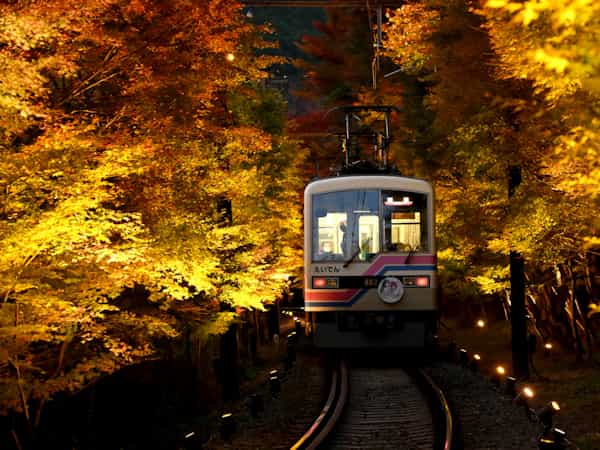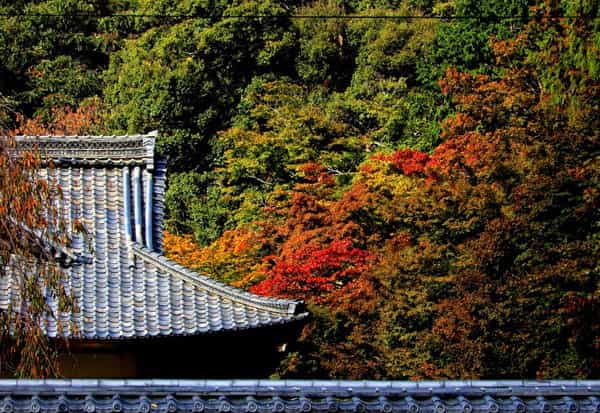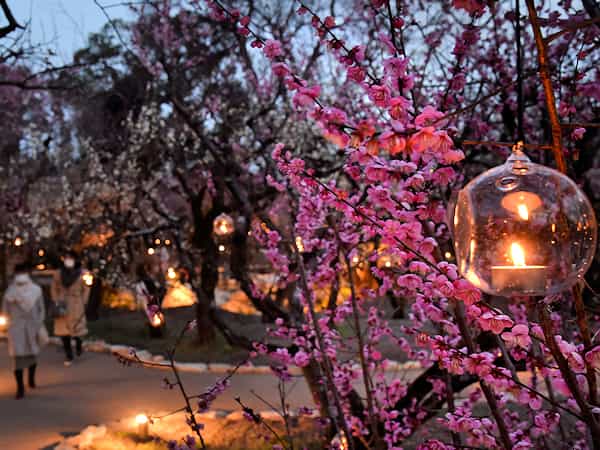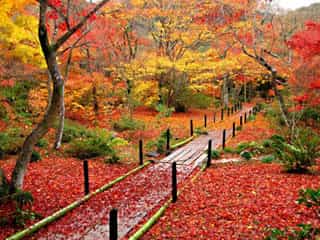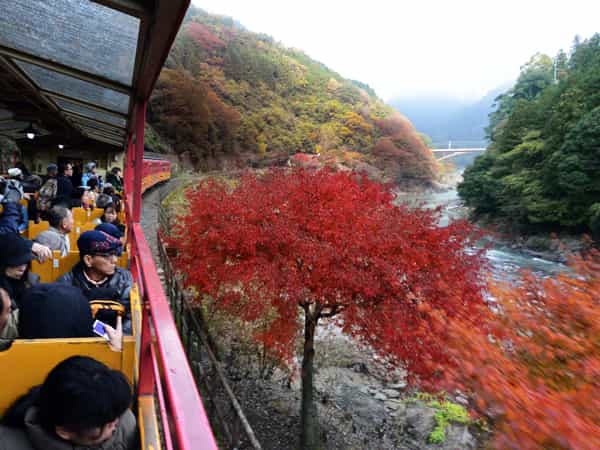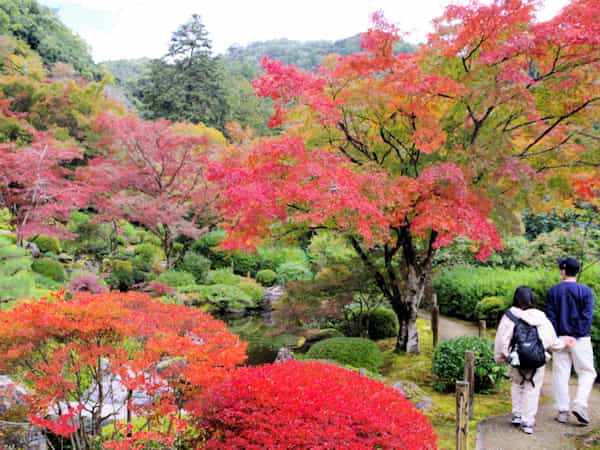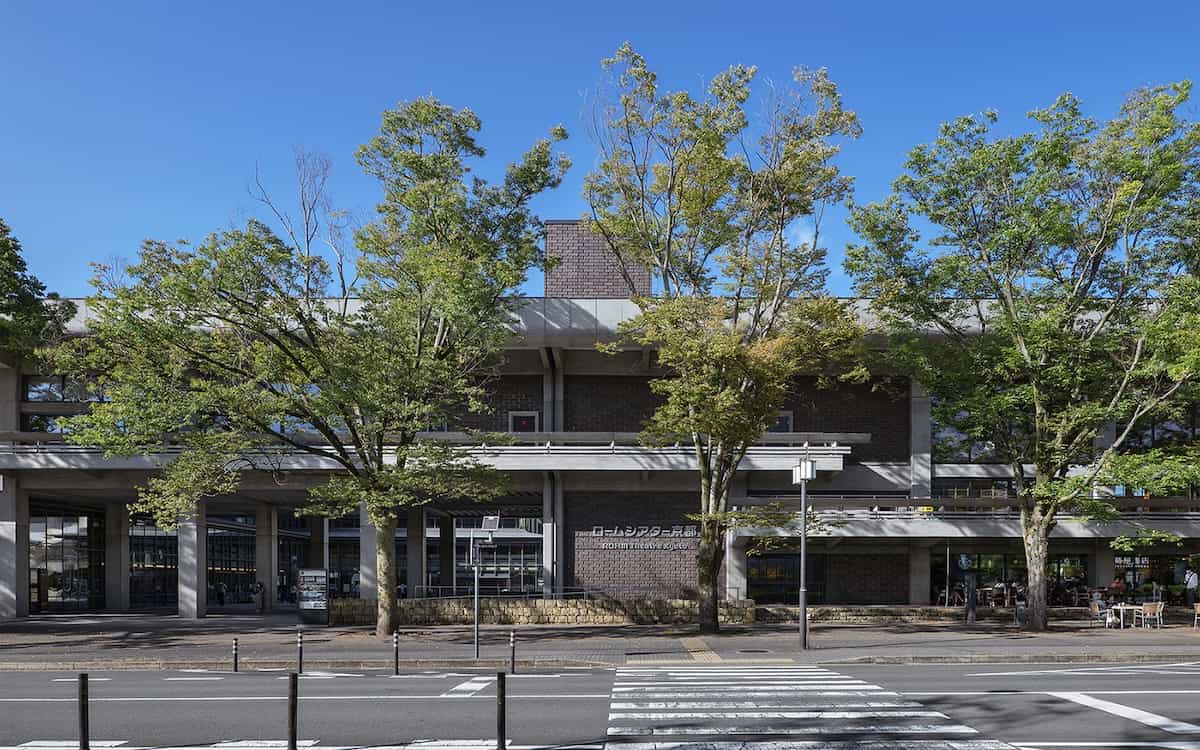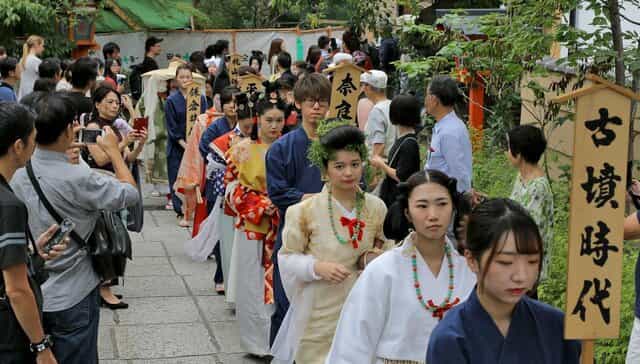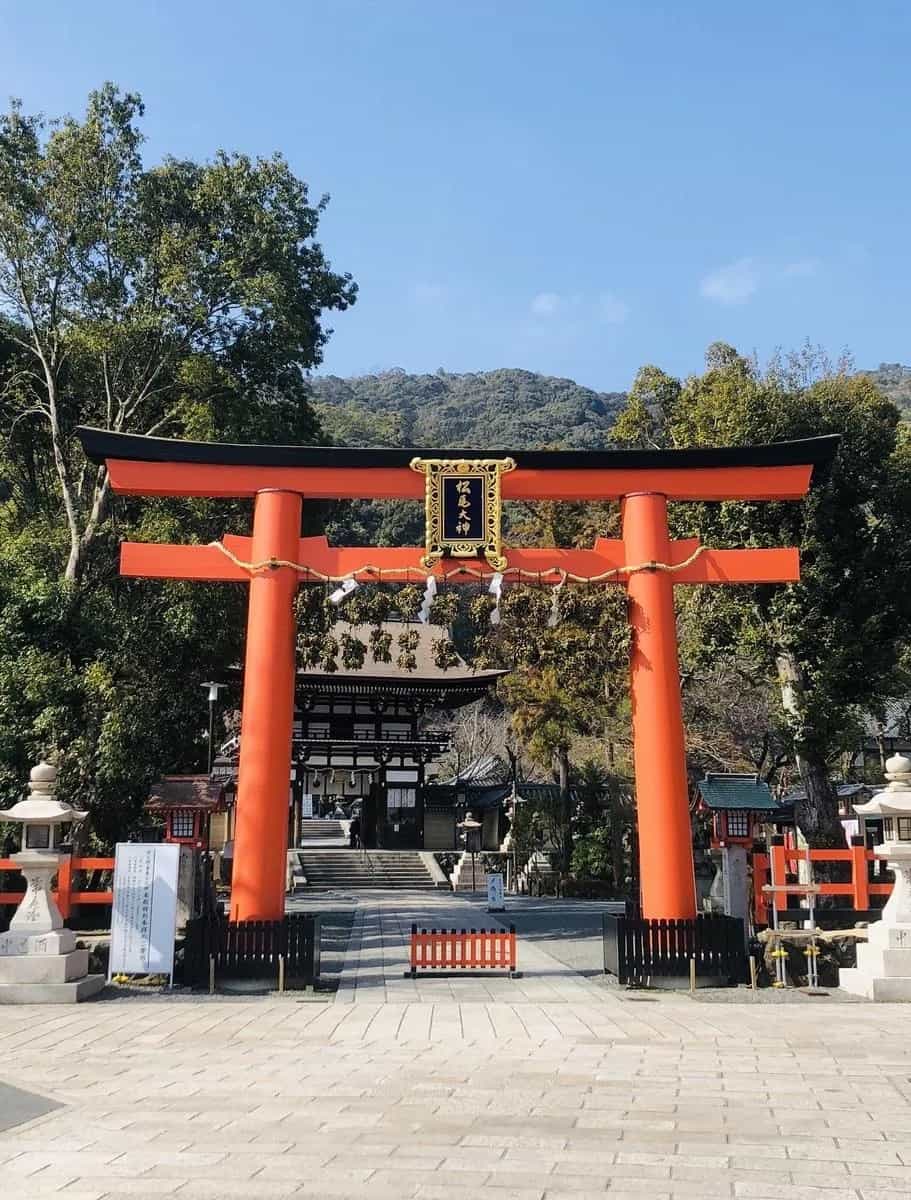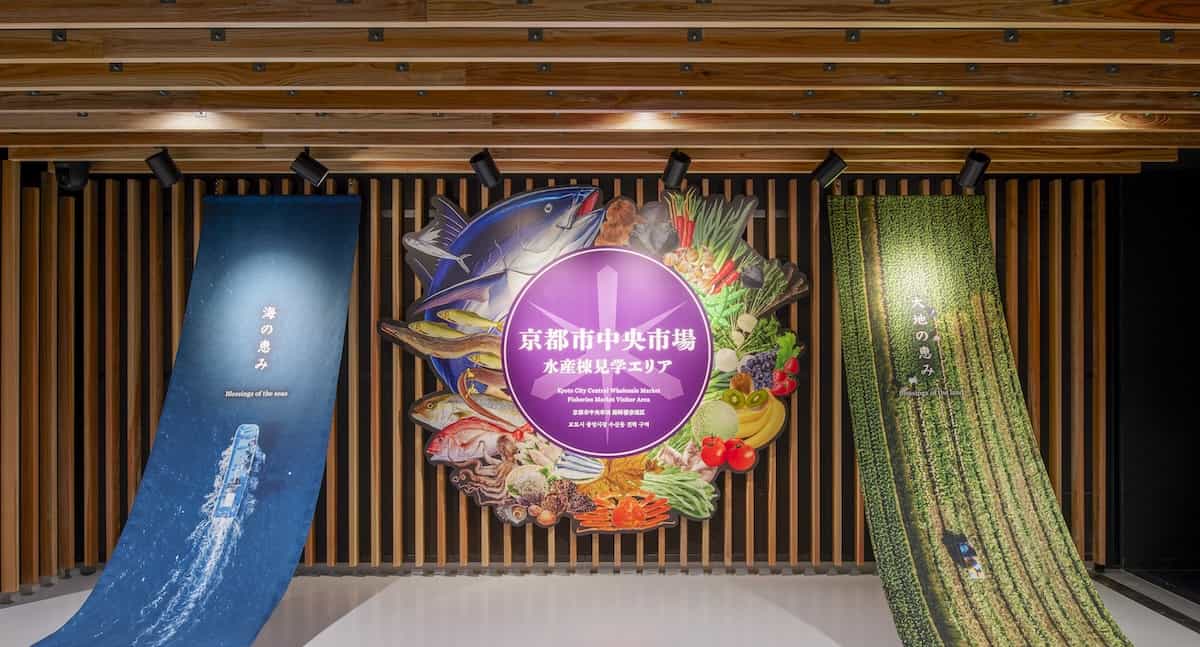京都イベントガイド 京都新聞&Stroly presents
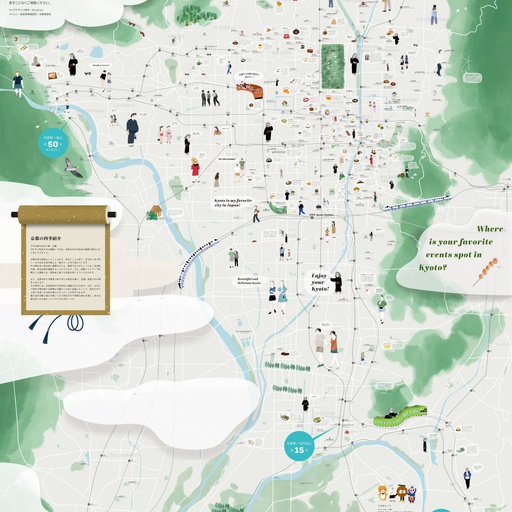
紅葉で染まる古都をイメージした美しいマップに、京都のランドマークが可愛らしいイラストで描かれています。 さらに、このマップには、寺院の特別公開やライトアップ、伝統行事、アートイベントなど、秋に開催される京都のイベント情報が満載! 見頃の紅葉情報と合わせて、あなただけのとっておきの京都の秋を見つけませんか?
すべてのスポット情報
127件のスポット
 落葉
落葉
「京の奥座敷」とも称され、貴船神社は森と水に囲まれる。秋は2003年に叡電が始めた沿線の「もみじのトンネル」のライトアップが人気。市原~二ノ瀬駅間の一部、約250メートルに約280本のモミジがあり、徐行する電車の窓からの眺めは幻想的だ。 11月1日~24日、「もみじのトンネル」のライトアップをはじめ、二ノ瀬駅や貴船口駅、貴船神社周辺で「貴船もみじ灯籠」がある。日没~午後9時(貴船神社周辺は午後8時30分まで)。 〒601-1112京都府京都市左京区鞍馬貴船町180GoogleMapで場所を見る 貴船神社本宮の開門時間は午前6時~午後8時 貴船神社は参拝無料(叡電は運賃必要) 叡山電車の出町柳駅から鞍馬線に乗車。終点・鞍馬駅の一つ手前、貴船口駅が貴船神社に近い 公式HP Instagram Facebook LINE X(Twitter) Youtube 情報提供:京都新聞 技術提供:Stroly (c)The Kyoto Shimbun Co.,Ltd. All rights reserved.
自然の地形を巧みに利用した境内には、有清園(ゆうせいえん)・聚碧園(しゅうへきえん)と呼ばれる二つの美しい庭園があり、山もみじの紅葉が素晴らしい。宸殿から往生極楽院に通じる有清園では杉木立の中に広がる苔の緑と紅葉のコントラストが美しい。10月28日~11月28日には「もみじまつり」を開催し、通常秘仏の金色不動明王を御開扉する。 〒601-1242京都府京都市左京区大原来迎院町540GoogleMapで場所を見る 【3月~10月】午前9時~午後5時【11月】午前8時30分~午後5時【12月~2月】午前9時~午後4時30分 一般700円、中高生400円、小学生150円 京都駅、叡電・出町柳駅、市営地下鉄・国際会館駅から京都バス・大原下車。京都駅からはバス約60分。大原バス停から徒歩約10分 公式HP Instagram Facebook LINE X(Twitter) Youtube 情報提供:京都新聞 技術提供:Stroly (c)The Kyoto Shimbun Co.,Ltd. All rights reserved.
山水庭園と、江戸時代から続く造園業者、小川勝章氏監修の石庭「こころのお庭」の二つの庭が紅葉に染められる。滝の間の板張りの床には庭の紅葉が映り込み「床もみじ」と呼ばれる。新緑の時季の「床みどり」も美しい。客殿には鎌倉時代の作と伝わる本尊・木造不動明王立像や、江戸時代の狩野派のふすま絵がある。 〒606-0017京都府京都市左京区岩倉上蔵町121GoogleMapで場所を見る 午前9時~午後5時 一般500円、小中生250円 市営地下鉄・国際会館駅から京都バス・岩倉実相院下車。叡電・岩倉駅から徒歩約20分 公式HP Instagram Facebook LINE X(Twitter) Youtube 情報提供:京都新聞 技術提供:Stroly (c)The Kyoto Shimbun Co.,Ltd. All rights reserved.
国宝2棟と重文41棟を含む広大な敷地はすべてユネスコ世界文化遺産「古都京都の文化財」の一つとして登録されている。「ならの小川」と呼ばれるせせらぎ沿いや、神馬(しんめ)舎がある二ノ鳥居、平安装束に身を包んで和歌を詠む「賀茂曲水宴」の舞台・渉渓園(しょうけいえん)など、真っ赤なモミジが美しい。 〒603-8047京都府京都市北区上賀茂本山339GoogleMapで場所を見る 5:30〜17:00 拝観自由 京都市バス「上賀茂神社前」下車 公式HP Instagram Facebook LINE X(Twitter) Youtube 情報提供:京都新聞 技術提供:Stroly (c)The Kyoto Shimbun Co.,Ltd. All rights reserved.

広さ5500平方メートルの「なからぎの森」周辺にはカエデなどの落葉樹が多く、大小三つの池に約200本のイロハモミジが映える色彩は美しい。また、あじさい園には国内最大級のフウが鮮やかに色づく。 〒606-0823京都府京都市左京区下鴨半木町GoogleMapで場所を見る 9:00〜18:30(入園は午後6時まで) 一般200円高校生150円中学生以下無料70歳以上の方、障害者手帳等持参の方(介護者含む)は証明書提示で無料 京阪「出町柳」駅、「三条駅」から京都市バスで「植物園前」下車、徒歩約5分JR・近鉄「京都」駅、阪急「烏丸」駅から京都市営地下鉄「北山」駅3番出口すぐ 公式HP Instagram Facebook LINE X(Twitter) Youtube 情報提供:京都新聞 技術提供:Stroly (c)The Kyoto Shimbun Co.,Ltd. All rights reserved.
慶長6年(1601年)、徳川家康が教学振興のために創建した圓光寺は、僧俗を問わず学びの門を開いた学問所でした。孔子家語や貞観政要などを刊行し、伏見版・圓光寺版として知られます。現存する木活字約五万個は出版文化史上貴重な遺産です。本尊千手観音や円山応挙の屏風などを所蔵し、庭園「奔龍庭」「十牛之庭」や水琴窟が静寂な美を醸します。裏山には徳川家康を祀る東照宮もあります。 京都市左京区一乗寺小谷町13番地GoogleMapで場所を見る 9:00-17:00 公式HP Instagram Facebook LINE X(Twitter) Youtube 情報提供:京都新聞 技術提供:Stroly (c)The Kyoto Shimbun Co.,Ltd. All rights reserved.

銀閣寺から南禅寺(実際には若王子神社)まで続く約2kmの散歩道は、20世紀初頭の哲学者西田幾太郎が毎朝散歩していたことから「哲学の道」と名付けられました。日本最大の湖である琵琶湖から引かれた疎水が脇を流れ、桜の名所としても知られます。また、日本画家橋本関雪によって寄贈された関雪桜が道沿いに美しく並んでいます。 〒606-8402京都府京都市左京区銀閣寺町 哲学の道GoogleMapで場所を見る 【北側から歩く場合】京都駅から地下鉄烏丸線「丸太町」駅で下車。市バス204番に乗り換えて「銀閣寺道」下車京都駅から地下鉄烏丸線「今出川」駅で下車。市バス203番に乗り換えて「銀閣寺道」下車市バス 7番・5番「銀閣寺道」下車※観光シーズンには混み合いますので地下鉄からの乗り換えをおすすめします。【南側から歩く場合】地下鉄烏丸線「烏丸御池」駅で東西線へ乗り換え「蹴上駅」下車、徒歩約20分市バス5番「南禅寺永観堂前」下車※観光シーズンは混み合います 公式HP Instagram Facebook LINE X(Twitter) Youtube 情報提供:京都新聞 技術提供:Stroly (c)The Kyoto Shimbun Co.,Ltd. All rights reserved.

およそ3000本のモミジが境内に植わり、美しい紅葉を楽しめる。ライトアップでは、例年700基の照明が黄や赤に染まった色とりどりのモミジを照らす。放生池(ほうじょういけ)周辺では虫の音が響く中、水面に木々が映り込み、幻想的な雰囲気を際立たせる。 11月11日~12月1日の午後5時30分~午後9時(午後8時30分受付終了)。中学生以上700円 〒606-8445京都府京都市左京区永観堂町48GoogleMapで場所を見る 9:00〜17:00(受付は午後4時で終了) 一般600円、小中高生400円。ただし秋の寺宝展開催の11月11日~12月8日は、一般1000円、小中高生400円 京都市営地下鉄「蹴上」駅から徒歩約15分JR「京都」駅、京阪「三条」駅から京都市バス「南禅寺・永観堂道」下車、徒歩約3分 公式HP Instagram Facebook LINE X(Twitter) Youtube 情報提供:京都新聞 技術提供:Stroly (c)The Kyoto Shimbun Co.,Ltd. All rights reserved.

知恩院は浄土宗の総本山で、法然上人が1175年に開基し、徳川家康や秀忠、家光らにより現在の壮大な伽藍が形成された。境内には国宝や多くの文化財指定建造物が建ち並ぶ。友禅苑や大方丈、小方丈、方丈庭園など見どころが多く、濡髪大明神は縁結びの神様「濡髪さん」として親しまれる。毎年11月25日には護摩焚きの大祭が行われ、紫雲水は清水として有名。 〒605-8686京都府京都市東山区林下町400GoogleMapで場所を見る 閉門時間は16:00開門時間は時期により異なります詳しくはこちら 友禅苑大人(高校生以上)300円小人(小・中学生)150円方丈庭園大人400円小人200円共通券大人400円小人200円 京都市営地下鉄東西線「東山」駅より徒歩で約8分阪急「京都河原町」駅より徒歩で約15分京阪「祇園四条」駅より徒歩で約10分 公式HP Instagram Facebook LINE X(Twitter) Youtube 情報提供:京都新聞 技術提供:Stroly (c)The Kyoto Shimbun Co.,Ltd. All rights reserved.

円山公園の象徴的存在である「祇園しだれ桜」は、円山公園の中心に位置し、通称「祇園の夜桜」として知られています。正式名は「一重白彼岸枝垂桜(ひとえしろひがんしだれざくら)」で、現在2代目の祇園しだれ桜は昭和3年(1928)に15代佐野藤右衛門氏によって初代のサクラ種子から育成、昭和24年(1949)に現在の場所に植栽され、樹高12m、幹回り2.8m、枝張り10mの美しい姿をしています。気軽に散策できる円山公園は名勝としても有名で、その歴史は長く、遊興の地として人々が集まりにぎわってきた場所です。 〒605-0071京都府東山区円山町GoogleMapで場所を見る 京阪「祇園四条」駅から徒歩約10分阪急「河原町」駅から徒歩約14分地下鉄「東山」駅から徒歩約15分 公式HP Instagram Facebook LINE X(Twitter) Youtube 情報提供:京都新聞 技術提供:Stroly (c)The Kyoto Shimbun Co.,Ltd. All rights reserved.

山麓にある古刹で、参道や石段の続く仁王門、勅使門など一面が紅葉に包まれるさまは圧巻。境内の庭園や弁天堂の周囲でも、美しく色づいた光景が満喫できる。2024年11月23日は「もみじ祭」が開かれ、午前10時から琴演奏やミュージックアンサンブル・チェロ演奏、和太鼓演奏などが行われる。 〒607-8003京都府京都市山科区安朱稲荷山町18GoogleMapで場所を見る 3月~11月:9:00~17:00(16:30受付終了)12月~2月:9:00~16:30(16:00受付終了) 一般500円高校生400円小学生300円 JR山科駅、市営地下鉄山科駅、京阪山科駅下車、徒歩約20分 公式HP Instagram Facebook LINE X(Twitter) Youtube 情報提供:京都新聞 技術提供:Stroly (c)The Kyoto Shimbun Co.,Ltd. All rights reserved.
境内は約1000本の紅葉に彩られる。特にライトアップされた臥龍池(がりょうち)では、周囲の色づいた木々が水面に映える光景が素晴らしい。2024年の本年は豊臣秀吉の正室高台院(北政所ねね)没後400年であり、その心情に思いをはせられるよう、光や音と融合させたプロジェクションマッピングが方丈の前庭「波心庭(はしんてい)」で繰り広げられる。 10月25日~12月15日の午後5~10時(午後9時30分受付終了) 〒605-0825京都府京都市東山区高台寺下河原町526GoogleMapで場所を見る 9:00〜17:30 (17:00受付終了)※17時に受付終了いたします。夜間特別拝観期間中は拝観時間を延長いたします。 大人600円中高生250円小学生以下無料(要保護者同伴) JR「京都」駅、四条河原町から京都市バス「東山安井」下車、徒歩約7分 公式HP Instagram Facebook LINE X(Twitter) Youtube 情報提供:京都新聞 技術提供:Stroly (c)The Kyoto Shimbun Co.,Ltd. All rights reserved.

境内には約1000本のモミジが植えられている。本堂崖下の渓谷・錦雲渓(きんうんけい)の紅葉の壮観さは、北山の高雄をほうふつとさせ「新高雄」とも呼ばれる。ライトアップは例年500基の照明を設置。奥の院からの眺望は、市街地の夜景を背景に赤く色づいたモミジが浮かび上がり、観音菩薩(ぼさつ)の慈悲を表現した青い光線が西の空に向かって伸びる。 ライトアップは11月18日~30日の午後5時30分~午後9時(受付終了、夕方の閉門なし) 〒605-0862京都府京都市東山区清水1丁目294GoogleMapで場所を見る 6:00〜18:00時期により異なります。詳細はこちら 大人400円小中学生200円 ・京阪電車「清水五条」駅より徒歩約25分・JR「京都」駅、阪急電車「四条河原町」駅から京都市バスで「清水道」下車、徒歩約10分 公式HP Instagram Facebook LINE X(Twitter) Youtube 情報提供:京都新聞 技術提供:Stroly (c)The Kyoto Shimbun Co.,Ltd. All rights reserved.

本堂と開山堂を結ぶ橋廊「通天橋」の一帯は、洗玉澗(せんぎょくかん)と呼ばれる渓谷で、京都屈指の紅葉の名所。カエデを中心に境内は約2000本の紅葉に彩られる。通天橋の張り出しからのぞき込む洗玉澗はもちろん、散歩道を下りて見上げる通天橋の景色も美しい。 11月16日~12月1日の午後5時半~7時半(予約制) 〒605-0981京都府京都市東山区本町15丁目778GoogleMapで場所を見る 4月~10月末まで:9:00~16:30(受付終了16:00) 11月~12月 第1日曜日まで:8:30~16:30(受付終了16:00)12月 第1月曜日~3月末:9:00~16:00(受付終了15:30) 本坊庭園大人500円小中学生300円通天橋大人1000円小中学生300円 京阪、JR「東福寺」駅下車、徒歩約10分京阪「鳥羽街道」駅下車、徒歩約8分JR「京都」駅、阪急「四条河原町」駅から京都市バス「東福寺」下車、徒歩約10分 公式HP Instagram Facebook LINE X(Twitter) Youtube 情報提供:京都新聞 技術提供:Stroly (c)The Kyoto Shimbun Co.,Ltd. All rights reserved.
昨年以前の様子 学問の神様、菅原道真公をまつる全国天満宮・天神社の総本社。紅葉の季節には、史跡御土居の「もみじ苑」が特別公開される。もみじ苑には樹齢400年を超える大木など約350本のモミジが植わる。御土居を埋め尽くすように、赤く染まった葉が折り重なる様子は風情たっぷり。ライトアップにより、紅葉や御社殿が夜の街に幻想的に浮かび上がる。 11月9日~12月8日の日没~午後8時(午後7時40分受付終了) 〒602-8386京都府京都市上京区馬喰町GoogleMapで場所を見る 7:00〜17:00 境内無料 京都市バス「北野天満宮前」下車嵐電「北野白梅町」駅下車、徒歩約5分 公式HP Instagram Facebook LINE X(Twitter) Youtube 情報提供:京都新聞 技術提供:Stroly (c)The Kyoto Shimbun Co.,Ltd. All rights reserved.

城内には紅葉の美しい樹木が多数植栽されており、11月中旬から12月中旬ごろまで秋の彩りを楽しむことができる。清流園の南側の小径では真っ赤に染まった木々の間を散策できる。本丸西橋付近や桜の園にはイチョウの大木があり、お城と紅葉の調和を楽しめる。3つの庭園では、松の緑と紅葉の対比も美しい 10月25日~12月8日午後6時~9時(午後10時閉場)。昼夜入れ替え制。月~木曜は中学生以上2400円、小学生1600円。金土日祝は中学生以上2400円、小学生1600円。当日入場チケットの窓口販売は午後6時から 〒604-8301京都府京都市中京区二条通堀川西入二条城町541GoogleMapで場所を見る 8:45〜16:00(閉城 17:00) 入城料(二の丸御殿観覧料含む)大人1300円中高生400円小学生300円 京都市営地下鉄「二条城前」駅JR「京都」駅から京都市バス9・50号、「二条城前」下車JR「二条」駅から徒歩17分 公式HP Instagram Facebook LINE X(Twitter) Youtube 情報提供:京都新聞 技術提供:Stroly (c)The Kyoto Shimbun Co.,Ltd. All rights reserved.

梅小路公園が誇る平成の日本庭園『朱雀の庭』には、約150本のモミジが植えられています。11月中旬頃からは庭園外周付近のモミジや朱雀の庭など、公園内のあちこちが美しい紅葉に彩られます。 〒600-8835京都府京都市下京区観喜寺町56−3GoogleMapで場所を見る JR嵯峨野線「梅小路京都西」駅下車すぐ「京都」駅(JR・地下鉄・近鉄)中央口より塩小路通を西へ徒歩約15分 公式HP Instagram Facebook LINE X(Twitter) Youtube 情報提供:京都新聞 技術提供:Stroly (c)The Kyoto Shimbun Co.,Ltd. All rights reserved.

市街地から離れた高雄山中腹に位置する真言宗の古刹(こさつ)、神護寺は京都市内よりも一足早く紅葉が楽しめる。清滝川から続く古びた石段の参道と、山門をくぐった広大な境内の随所にモミジが植わり、紅葉の名所として知られる。国宝の梵鐘は日本三名鐘の一つに数えられる。 〒616-8292京都府京都市右京区梅ケ畑高雄町5GoogleMapで場所を見る 9:00〜16:00 大人・中学生以上800円小学生400円 JR「京都」駅からJRバス栂ノ尾行き「高雄」下車、徒歩約20分四条烏丸から京都市バス「高雄」下車、徒歩約20分 公式HP Instagram Facebook LINE X(Twitter) Youtube 情報提供:京都新聞 技術提供:Stroly (c)The Kyoto Shimbun Co.,Ltd. All rights reserved.

1450年に細川勝元によって徳大寺家の別荘から妙心寺として禅寺に改められた臨済宗妙心寺派。石庭として有名な方丈庭園(史跡・特別名勝)は三方を築地塀に囲まれた枯山水の平庭で、「虎の児渡しの庭」とも呼ばれる。白砂に15個の石を配した名庭。1994年には「古都京都の文化財」として世界遺産に登録されました。 〒616-8001京都府京都市右京区龍安寺御陵ノ下町13GoogleMapで場所を見る 3月1日~11月30日:8:00〜17:0012月1日~2月末日:8:30〜16:30 大人 600円高校生 500円小・中学生 300円 京福電鉄 龍安寺駅下車 徒歩7分 公式HP Instagram Facebook LINE X(Twitter) Youtube 情報提供:京都新聞 技術提供:Stroly (c)The Kyoto Shimbun Co.,Ltd. All rights reserved.
京都では珍しい道路に面した「二王門」(京都3大門のひとつ)より足を一歩踏み入れると、広大な境内には国宝の「金堂」をはじめ、重要文化財の「五重塔」「御影堂」「観音堂」や、御殿内の「遼廓亭」「飛濤亭」などがあります。皇族や貴族とのゆかりが深かったため「仁和寺御殿」といわれる御所風建築物が特長です。 〒616-8092京都府京都市右京区御室大内33GoogleMapで場所を見る 9:00~17:00 大人800円高校生以下無料 京福電車「御室仁和寺」下車、徒歩約3分 公式HP Instagram Facebook LINE X(Twitter) Youtube 情報提供:京都新聞 技術提供:Stroly (c)The Kyoto Shimbun Co.,Ltd. All rights reserved.

嵯峨天皇の離宮を寺院に改めた優雅なたたずまいに、紅葉が映える。境内の東に広がる大沢池は、平安時代に貴族が舟遊びを楽しんだとされる。周囲を赤く染まったモミジが囲み、水面(みなも)に映る様も美しい。大沢池ライトアップは広大なエリアを幻想的で柔らかな光で照らし出す。 11月15日~12月1日に「大沢池ライトアップ」。昼夜入れ替え制で、午後5時30分~8時30分(午後8時受付終了)。大人900円、小中高生500円 〒616-8411京都府京都市右京区嵯峨大沢町4GoogleMapで場所を見る 9:00〜17:00(受付は16時30分まで) お堂エリア大人500円・小中高生300円大沢池エリア大人300円・小中高生100円 ・京都市バス、京都バス「大覚寺」下車すぐ・JR「嵯峨嵐山」駅から徒歩約20分 公式HP Instagram Facebook LINE X(Twitter) Youtube 情報提供:京都新聞 技術提供:Stroly (c)The Kyoto Shimbun Co.,Ltd. All rights reserved.
奥行きのある境内。まっすぐな石畳の両側にカエデやドウダンツツジの木々が続き格別の美しさ。初夏の新緑や冬の雪景色など、それぞれの季節ごとに異なった風情ある庭園が楽しめる。奥まったところには楠木正行(まさつら)の首塚と足利義詮(よしあきら)の墓がある。 〒616-8424京都府京都市右京区嵯峨釈迦堂門前南中院町9GoogleMapで場所を見る 9:00〜16:00 一般500円、小中生200円 JR・嵯峨嵐山駅から徒歩約15分。市バス・嵯峨釈迦堂前下車、徒歩約5分 公式HP Instagram Facebook LINE X(Twitter) Youtube 情報提供:京都新聞 技術提供:Stroly (c)The Kyoto Shimbun Co.,Ltd. All rights reserved.

妙心寺塔頭の一つ。40余りある塔頭で通年拝観が可能なのはここを含めて3院ほど。およそ600年余り前、波多野出雲守重通が建立したとされる。見どころは二つある庭で、一つは室町時代の狩野元信作庭の枯山水庭園、もう一つは昭和の名庭である城南宮楽水苑などを手がけた中根金作氏作庭の余香苑。紅葉は余香苑で楽しめる。 〒616-8035京都府京都市右京区花園妙心寺町35GoogleMapで場所を見る 9:00~17:00(受付終了)※休園なし 一般600円(高校生含む)小中学生300円(小学生未満の幼児は無料、但し保護者同伴に限る) JR山陰(嵯峨野)線(亀岡・福知山方面行き)「花園駅」下車、徒歩約7分嵐電 帷子ノ辻駅乗り換え北野白梅町行き「妙心寺駅」下車、徒歩約10分 公式HP Instagram Facebook LINE X(Twitter) Youtube 情報提供:京都新聞 技術提供:Stroly (c)The Kyoto Shimbun Co.,Ltd. All rights reserved.

本堂に向けて約200メートル続く広くなだらかな参道は「もみじの馬場」と呼ばれる。参道石段付近の紅葉風景は、観光ポスターなどにも取り上げられる。平安時代、和歌に詠まれた小倉山のもみじは、今なお美しい。 〒616-8425京都府京都市右京区嵯峨二尊院門前長神町27GoogleMapで場所を見る 9:00~16:30(受付終了) 大人(中学生以上):500円小人(小学生以下):無料 京福嵐山本線 嵐山駅下車 徒歩15分JR山陰本線 嵯峨嵐山駅下車徒歩19分 公式HP Instagram Facebook LINE X(Twitter) Youtube 情報提供:京都新聞 技術提供:Stroly (c)The Kyoto Shimbun Co.,Ltd. All rights reserved.

嵐山と相対するように桂川の北岸(左岸)にある小倉山。常寂光寺はその小倉山の麓から中腹まで広がり、境内全体が紅葉で色づく。本堂へと上る石段の両側はカエデの老木が生い茂る。特に多宝塔あたりの紅葉は見逃せない。眼下に嵯峨野を見おろす景観も美しい。 〒616-8397京都府京都市右京区嵯峨小倉山小倉町3GoogleMapで場所を見る 9:00〜17:00 ( 16:30受付終了) 500円 JR「嵯峨嵐山」駅下車、徒歩約20分嵐電「嵐山」駅下車、徒歩約25分JR「京都」駅、京阪「三条」駅から京都市バス「嵯峨小学校前」下車、徒歩約15分 公式HP Instagram Facebook LINE X(Twitter) Youtube 情報提供:京都新聞 技術提供:Stroly (c)The Kyoto Shimbun Co.,Ltd. All rights reserved.
亀岡市の保津橋付近から京都市の嵐山・渡月橋に至る保津峡は京都屈指の渓谷美で知られている。渓谷沿いの7.3キロを約25分かけてゆっくりと進む嵯峨野観光鉄道の嵯峨野トロッコ列車や、渓流約16キロを約2時間で下る保津川遊船企業組合の保津川下りで、渓谷の紅葉を楽しめる。トロッコ列車沿線ライトアップでは、夜の闇に浮かび上がるカエデなど約1000本を楽しめる。 嵯峨野トロッコ列車の沿線をライトアップ。10月14日~12月29日のうち、運休日の12月6、13、20、27日を除く毎日。期間中は臨時列車の運行もある。午後4時半~最終列車まで。乗車料金のみ(ライトアップ料金なし)。 〒621-0005京都府亀岡市保津町保津山2GoogleMapで場所を見る 嵯峨野トロッコ列車(大人880円、小人440円)や保津川下り(大人6000円、幼児から小学生まで4500円)は料金が必要 トロッコ列車はJR嵯峨嵐山駅近くのトロッコ嵯峨駅下車からJR馬堀駅近くのトロッコ亀岡駅まで運行。保津川下りの乗船場はJR亀岡駅近く。乗船場までJR亀岡駅から徒歩約10分、トロッコ亀岡駅からは京阪京都交通バスで約15分 公式HP Instagram Facebook LINE X(Twitter) Youtube 情報提供:京都新聞 技術提供:Stroly (c)The Kyoto Shimbun Co.,Ltd. All rights reserved.

嵐山、亀山、小倉山を借景とした池泉回遊式(ちせんかいゆうしき)の曹源池(そうげんち)庭園は国の史跡・特別名勝の第1号で、回遊式庭園では最も古い遺構という。「日本の庭に初めて深い思想性を持たせた」といわれる鎌倉~室町時代の禅僧・夢窓国師(むそうこくし)の作庭で、四季の美しさを見せる。11月16~12月1日は午前7時30分に開門し、ゆっくりと庭園参拝ができる。 〒616-8385京都府京都市右京区嵯峨天龍寺芒ノ馬場町68GoogleMapで場所を見る 8:30~17:00(受付終了16:50)《特別早朝参拝》庭園期間:2024/11/16(土)~12/1(日)時間:7:30~(庭園受付のみ、北門受付は午前8時30分~) 庭園(曹源池・百花苑)・高校生以上:500円・小中学生 :300円・未就学児 :無料諸堂(大方丈・書院・多宝殿)・庭園参拝料に300円追加行事等により諸堂参拝が出来ない日がございます法堂「雲龍図」特別公開・一人500円(上記通常参拝料とは別) 京福電鉄嵐山線「嵐山」駅 下車 すぐJR嵯峨野線「嵯峨嵐山」駅下車徒歩13分阪急電車「嵐山」駅下車 徒歩15分 公式HP Instagram Facebook LINE X(Twitter) Youtube 情報提供:京都新聞 技術提供:Stroly (c)The Kyoto Shimbun Co.,Ltd. All rights reserved.

嵐山は大堰川(桂川)の右岸(南側)の山で、高さ382メートル。対岸の小倉山を含めた周辺は紅葉の名所で、紅葉シーズンはおおぜいの観光客で混雑する。小倉山に続く亀山公園は紅葉が多く、その頂上展望台からは紅葉の渓谷の中を保津川下りの船がゆっくりと下って来るのが見える。渡月橋上流では毎年11月第2日曜日午前10時~午後3時に「嵐山もみじ祭り」が開かれ、ゆかりのある芸能が繰り広げられる。 〒616-0007京都府京都市右京区嵐山GoogleMapで場所を見る 嵐電・阪急「嵐山」駅下車、徒歩約5〜10分京阪「三条」駅から京都バスか京都市バスで「嵐山」下車JR京都駅から京都市バスで「嵐山公園」下車かJRバスで「嵐山」下車 公式HP Instagram Facebook LINE X(Twitter) Youtube 情報提供:京都新聞 技術提供:Stroly (c)The Kyoto Shimbun Co.,Ltd. All rights reserved.
深紅、朱、黄、オレンジ色…。境内だけでなく向かいの山も、さまざまな種類のモミジに染まる。本堂前、阿弥陀堂への石段と歩きめぐるほどに鮮やかな紅葉が広がる。境内の奥の院まで上がれば、京都市内も一望できる。西国三十三所観音霊場の第20番札所で、樹齢600年以上、全長37メートルの国指定天然記念物「遊龍の松」が有名。 〒610-1133京都府京都市西京区大原野小塩町1372GoogleMapで場所を見る 土日祝は午前8時・平日は午前8時30分~午後5時(午後4時45分受付終了) 大人500円、高校生300円、小中生200円 阪急・長岡天神駅からタクシー約20分。JR・向日町駅からタクシー約20分。JR・向日町駅、阪急・東向日駅から阪急バス・善峯寺下車、徒歩約10分 公式HP Instagram Facebook LINE X(Twitter) Youtube 情報提供:京都新聞 技術提供:Stroly (c)The Kyoto Shimbun Co.,Ltd. All rights reserved.

京都駅からJR琵琶湖線(東海道線)で、ひと駅の山科エリア。水量豊かな琵琶湖から京都へと水を運ぶ琵琶湖疏水の一部で、通称「山科疏水」と呼ばれる。遊歩道が整備された散策コースで、両岸にはサクラも植わる。びわ湖疏水船「四ノ宮船溜(ふなだまり)」周辺の紅葉が素晴らしい。山科の紅葉の名所、毘沙門堂にも近い。 〒607-8016京都府京都市山科区安朱中溝町48GoogleMapで場所を見る JR・山科駅、京阪・京阪山科駅、市営地下鉄・山科駅から徒歩約10分 公式HP Instagram Facebook LINE X(Twitter) Youtube 情報提供:京都新聞 技術提供:Stroly (c)The Kyoto Shimbun Co.,Ltd. All rights reserved.
京都市東山区・月輪山の麓に位置する泉涌寺は、真言宗泉涌寺派の総本山であり、「御寺(みてら)」の名でも親しまれ、古くから皇室の菩提寺としての役割を果たしてきました。 境内には歴代天皇の尊牌を祀る「霊明殿」などがあり、格調高い寺院空間を構成しています。春の新緑、秋の紅葉と自然の彩りも豊かで、静かに仏を拝むひとときを得られます。 〒605-0977 京都市東山区泉涌寺山内町27GoogleMapで場所を見る 3月~11月 9:00〜16:30(閉門17:00)/12月~2月 9:00〜16:00(閉門16:30) 伽藍拝観 大人 500円 /子供 300円(小中学生) 特別拝観 大人 500円(中学生以上) 京都駅(烏丸口)から、市バス(208)にて泉涌寺道下車、徒歩15分 東福寺駅(奈良線)から徒歩20分 公式HP Instagram Facebook LINE X(Twitter) Youtube 情報提供:京都新聞 技術提供:Stroly (c)The Kyoto Shimbun Co.,Ltd. All rights reserved.

昨年以前の様子 国風文化が花開いた鳥羽離宮の鎮守の社。王朝ロマンが漂う神苑「楽水苑」の紅葉が華麗。紅葉の赤が苔の緑に映え、池の水面にも鮮やかに映し出される。また秋咲きの椿も楽しめる。「昭和の小堀遠州」とたたえられた中根金作氏が作庭した。 〒612-8459京都府京都市伏見区中島鳥羽離宮町7GoogleMapで場所を見る 9:00〜16:30(16:00受付終了) 時期により異なります。 京都市営地下鉄「竹田」駅下車、徒歩15分 公式HP Instagram Facebook LINE X(Twitter) Youtube 情報提供:京都新聞 技術提供:Stroly (c)The Kyoto Shimbun Co.,Ltd. All rights reserved.

広大な境内のあちらこちらで紅葉がゆったり楽しめる。背後にある東山連峰の大日山を借景にした庭園は、四季折々の植物が彩り、それぞれに美しい風情を見せる。およそ大きさ6600平方メートルの氷室池(ひむろいけ)があり、カキツバタやスイレンの名所としても知られている。 〒607-8226京都府京都市山科区勧修寺仁王堂町27-6GoogleMapで場所を見る 9:00~16:30(受付終了16:00) 一般500円 京都市営地下鉄「小野」駅下車、徒歩約6分 公式HP Instagram Facebook LINE X(Twitter) Youtube 情報提供:京都新聞 技術提供:Stroly (c)The Kyoto Shimbun Co.,Ltd. All rights reserved.
11月上旬、山頂から少しずつ色づきはじめる醍醐山。中旬から12月上旬にかけては、まさに満山錦繍(まんざんきんしゅう)の美しさとなる。国の特別史跡・特別名勝で、豊臣秀吉が「醍醐の花見」に際して自ら基本設計をしたといわれる三宝院庭園は、桃山時代の華やかな雰囲気を伝える。 11月22日~12月1日の午後6時~午後8時50分(午後8時10分受付終了)。秋期夜間伽藍拝観料1000円(昼夜入れ替え制) 〒601-1325京都府京都市伏見区醍醐東大路町22GoogleMapで場所を見る 夏期3月1日〜12月第1日曜日午前9時〜午後5時まで冬期12月第1日曜日の翌日〜2月末日午前9時〜午後4時30分まで※閉門時間30分前で受付終了(春期期間中は拝観時間の変更あり) 時期により異なります。詳しくは公式HPをご覧ください。 地下鉄東西線 醍醐駅より徒歩5分 公式HP Instagram Facebook LINE X(Twitter) Youtube 情報提供:京都新聞 技術提供:Stroly (c)The Kyoto Shimbun Co.,Ltd. All rights reserved.

昨年以前の様子 随心院は、正暦2年(991)に創建された真言宗善通寺派の大本山であり、本堂には貴重な如意輪観世音菩薩坐像(にょいりんかんのんざぞう)や阿弥陀如来坐像、金剛薩埵坐像(こんごうさったざぞう)が安置されています。小野小町の邸宅跡と伝えられ、文張地蔵尊立像や化粧井戸、文塚が残っています。庭園で美しい梅が楽しめ、毎年3月最終日曜には‘はねず踊り’と観梅の催しが行われます。 〒607-8257京都府京都市山科区小野御霊町35−35GoogleMapで場所を見る 9:00〜17:00(受付終了は16:30) 大人:500円身障者:400円中学生:300円 京都市営地下鉄 東西線「小野駅」より徒歩5分 公式HP Instagram Facebook LINE X(Twitter) Youtube 情報提供:京都新聞 技術提供:Stroly (c)The Kyoto Shimbun Co.,Ltd. All rights reserved.

法然上人ゆかりの西山浄土宗の総本山。 〒617-0811京都府京都府長岡京市粟生西条ノ内26-1GoogleMapで場所を見る 御影堂は午前9時から午後4時まで開いております。また、紅葉期を除いて総門は午後6時に閉門致します。 紅葉期を除いて無料紅葉期間(11月11日〜12月3日)は一般1000円、中高生500円 JR「長岡京」駅、阪急「長岡天神」駅から阪急バス「旭が丘ホーム前」下車(光明寺および近隣には駐車場がないため、公共交通機関をご利用下さい) 公式HP Instagram Facebook LINE X(Twitter) Youtube 情報提供:京都新聞 技術提供:Stroly (c)The Kyoto Shimbun Co.,Ltd. All rights reserved.

石清水八幡宮(いわしみずはちまんぐう)は、清和天皇の時代に豊前国(現・大分県)の宇佐八幡宮から御神霊を移し、貞観元(859)年、男山に創建された。平将門・藤原純友の乱を鎮めた後、国家鎮護の神社として皇室から厚い崇敬を受けた。明治初期には官幣大社に列せられ、石清水八幡宮として知られる。源氏一門の氏神として尊崇され、源義家もここで元服し、厄除や必勝の神として信仰を集める。 〒614-8005京都府八幡市八幡高坊30GoogleMapで場所を見る 南総門開閉門時間:6:00〜18:00授与所(御朱印含む):9:00〜16:00ご祈祷受付:9:00〜16:00 京阪電車「石清水八幡宮駅」下車参道ケーブル「八幡宮口駅」~「八幡宮山上駅」下車徒歩5分 公式HP Instagram Facebook LINE X(Twitter) Youtube 情報提供:京都新聞 技術提供:Stroly (c)The Kyoto Shimbun Co.,Ltd. All rights reserved.
周辺は、平安時代末期の僧侶で歌人の西行が紅葉を歌に詠むなど、古くから紅葉の名所として知られる。寺は境内にカエデなどを植樹し、枯れ山水の庭園も整備した。 〒611-0013京都府宇治市莵道滋賀谷21GoogleMapで場所を見る 8:30〜15:20 高校生以上1000円、3歳以上500円 京阪 三室戸駅下車、徒歩15分JR宇治駅よりタクシー 公式HP Instagram Facebook LINE X(Twitter) Youtube 情報提供:京都新聞 技術提供:Stroly (c)The Kyoto Shimbun Co.,Ltd. All rights reserved.
平等院は、平安時代の貴族文化を象徴する寺院です。1052年に藤原頼通が創建し、翌年には極楽浄土を表す阿弥陀堂「鳳凰堂」が建てられました。翼を広げた鳳凰を模した堂の姿は美しく、特に秋には紅葉と共に池に映る光景が観光客を魅了します。内部には国宝・阿弥陀如来坐像が安置され、隣接するミュージアム鳳翔館では貴重な寺宝も展示されています。歴史と美を感じられる平等院は、一見の価値がある名所です。 〒611-0021京都府宇治市宇治蓮華116GoogleMapで場所を見る 庭園:8:30〜17:30(受付終了)鳳凰堂内部拝観:9:30〜16:10(各回50名限定)※受付時間9:00〜 先着順により無くなり次第終了平等院ミュージアム鳳翔館:9:30〜17:00(受付終了:16:45)ミュージアムショップ:9:00〜17:00茶房 藤花:10:00〜16:30(ラストオーダー16:00)集印所:9:00〜17:00※帳面への記帳・書き置きの対応は日によって異なります。 【拝観料】庭園+平等院ミュージアム鳳翔館・大人:700円(個人)、600円(団体25名以上)・中高生:400円(個人)、300円(団体25名以上)・小学生:300円(個人)、200円(団体25名以上)鳳凰堂内部拝観・300円 JR・京阪「宇治駅」 公式HP Instagram Facebook LINE X(Twitter) Youtube 情報提供:京都新聞 技術提供:Stroly (c)The Kyoto Shimbun Co.,Ltd. All rights reserved.

宇治にある禅宗寺院。山門までのゆるやかな道は琴坂と呼ばれ、秋には紅葉のトンネルに変わる。カエデの色づきを楽しみながら約200メートルの散策を楽しみつつ境内へ。白い楼門と紅葉のコントラストも美しい。 〒611-0021京都府京都府宇治市宇治山田27-1GoogleMapで場所を見る 10:00~16:00※行事により、入山規制あり 500円(高校生以下無料) 京阪「宇治」駅下車、徒歩約15分JR「宇治」駅下車、徒歩約25分 公式HP Instagram Facebook LINE X(Twitter) Youtube 情報提供:京都新聞 技術提供:Stroly (c)The Kyoto Shimbun Co.,Ltd. All rights reserved.
 落葉近し
落葉近し
広さ3万6000坪(約11万8800平方メートル)の「糺(ただす)の森」には、樹齢600年から200年の樹木が約600本あるという。森の東を流れる瀬見の小川の周りには、たくさんのカエデの木が植えられている。紅葉するのは11月末ごろ。この時期、小雨の降るとき訪れると瀬見の小川が音もなく静かに流れ、雨が上がると一帯に薄い霧がたちこめて神秘的な雰囲気が漂う。 〒606-0807京都府京都市左京区下鴨泉川町59GoogleMapで場所を見る 6:00~17:00(神事等により変更の場合有り) 境内参拝自由大炊殿拝観は大人500円中学生以下無料 京阪「出町柳」駅から徒歩約10分JR「京都」駅、京阪「三条駅」から京都市バス「下鴨神社前」下車、徒歩約5分 公式HP Instagram Facebook LINE X(Twitter) Youtube 情報提供:京都新聞 技術提供:Stroly (c)The Kyoto Shimbun Co.,Ltd. All rights reserved.

向日神社は、京都府向日市にある奈良時代創建の古社で、本殿は室町時代の建築様式「三間社流造」で国の重要文化財に指定されています。春には桜祭りが行われ、祈願祭や生け花展、太鼓演奏などが催され夜はかがり火で桜を楽しめます。5月の神幸祭・還幸祭では神輿が町内を巡行し、7月には茅の輪くぐりで健康を祈願。10月には御火焚き祭が行われ、無病息災を祈る伝統的な行事が続けられています。 〒617-0005京都府向日市向日町北山65GoogleMapで場所を見る 阪急京都線「西向日駅」から徒歩10分 公式HP Instagram Facebook LINE X(Twitter) Youtube 情報提供:京都新聞 技術提供:Stroly (c)The Kyoto Shimbun Co.,Ltd. All rights reserved.
 イベントスポット
イベントスポット
京都・嵐山の中腹に位置する法輪寺は、和銅6年(713年)に僧行基が勅願を受け創建したと伝えられ、長い歴史を持つ古寺です。その後、弘法大師の弟子・道昌が虚空蔵菩薩を安置し、寺号を法輪寺としたとも伝わります。本尊虚空蔵菩薩は、智恵・福徳・技芸上達、そして丑年・寅年生まれの守護仏として信仰を集め、境内には「牛と虎」の石像があります。「十三まいり」(数え年13歳の男女が参詣して智恵と福徳を願う習わし)でも有名で、春の新緑や秋の紅葉と共に、嵐山・観光ルートのひとつとしても人気があります。 〒616-0006 京都府京都市西京区嵐山虚空蔵山町GoogleMapで場所を見る 公式HP Instagram Facebook LINE X(Twitter) Youtube 情報提供:京都新聞 技術提供:Stroly (c)The Kyoto Shimbun Co.,Ltd. All rights reserved.
柳谷観音(楊谷寺)は806年、清水寺開山の延鎮僧都が夢のお告げにより西山で生身の十一面千手千眼観世音菩薩を発見し開創しました。811年、空海が目を患った子ザルが親ザルに眼を洗われて治る姿を見て17日間祈祷し、独鈷水という霊水を生み出しました。以来、眼病平癒の祈願所として天皇家や公家の信仰を集め、霊元天皇が眼病を治癒されたことから明治まで独鈷水を献上していました。東山天皇の皇妃は子宝祈願で皇子を授かり、後の中御門天皇が追善菩薩を奥之院に奉納しました。現在も眼病平癒やがん封じで全国から参拝者が訪れ、1200年の伝統を誇ります。 〒617-0855 京都府長岡京市浄土谷堂ノ谷2GoogleMapで場所を見る 9時~17時(最終受付時間:16時30分) 阪急「西山天王山」駅・JR「長岡京」駅よりタクシー約15分。 毎月17日は阪急「西山天王山」駅・JR「長岡京」駅よりシャトルバスあり。 公式HP Instagram Facebook LINE X(Twitter) Youtube 情報提供:京都新聞 技術提供:Stroly (c)The Kyoto Shimbun Co.,Ltd. All rights reserved.
京都市伏見区、酒蔵の町並みや柳並木の運河を、江戸時代に淀川で米・酒・旅客を運んだ舟を復元した「十石舟」が巡る観光体験です。定員20名程度の舟で「月桂冠大倉記念館裏」乗船場から三栖閘門(みすこうもん)を経由して往復約50分、水辺から酒蔵や桜のトンネルなど四季の風景を楽しめます。水辺ならではのゆったりとした時間で、京都観光の“ちょっと違う視点”として人気です。 〒612-8043 京都府京都市伏見区南浜町247GoogleMapで場所を見る 大人1,900円(中学生以上)・小人900円(小学生以下) ※料金は変更になる場合があります。 ※身体・知的・精神障がい者割引:5割引 ※表示料金には消費税が含まれております。 公式HP Instagram Facebook LINE X(Twitter) Youtube 情報提供:京都新聞 技術提供:Stroly (c)The Kyoto Shimbun Co.,Ltd. All rights reserved.

京都市京セラ美術館は1933年に「大礼記念京都美術館」として開館した日本最古の公立美術館の一つです。長年の市民愛顧を受け、2020年には改修を経て再オープンし、新館「東山キューブ」やカフェ、ショップを備えたモダンな施設となりました。館内では近代から現代アートまで幅広い展覧会を開催し、新進作家を支援するスペースも設置。京都の芸術文化発信拠点として、国内外からの訪問者を魅了することを目指しています。 〒606-8344京都府京都市左京区岡崎円勝寺町124GoogleMapで場所を見る 展覧会情報はこちら開館時間10:00~18:00(最終入場時間は展覧会によって異なります。)休館日月曜日(祝・休日の場合は開館)年末年始(12月28日~1月2日) 公式HP Instagram Facebook LINE X(Twitter) Youtube 情報提供:京都新聞 技術提供:Stroly (c)The Kyoto Shimbun Co.,Ltd. All rights reserved.
京都府立堂本印象美術館
![]() イベントスポット
イベントスポット

堂本印象美術館は、日本画家・堂本印象が設立し、1966年に京都で開館しました。1991年に建物とコレクションが京都府に寄贈され、翌年「京都府立堂本印象美術館」として再開館しました。美術館の外観や内装はすべて堂本印象のデザインによるもので、彼がヨーロッパで見学した宮殿や邸宅を参考にして独自の美術館空間を創出したものです。館内には壁面装飾や装飾スケッチが多く残り、彼の創造への情熱が感じられる場所です。 〒603-8355京都府京都市北区平野上柳町26-3GoogleMapで場所を見る 展覧会情報はこちら開館時間9:30~17:00(入館は閉館30分前まで)休館日月曜日(祝休日の場合は開館し、翌平日に休館) 年末年始(12月28日~1月4日)※その他、展示替えなどで臨時休館することがあります。 一般510円(400円)/ 高大生400円(320円)/ 小中生200円(160円)※( )内は団体料金(20名以上)・小学生以下の方は無料です。※65歳以上の方は無料です。(公的な証明書が必要です)※各種障害者手帳・ミライロIDご提示の方とその介護者1名は無料です。 公式HP Instagram Facebook LINE X(Twitter) Youtube 情報提供:京都新聞 技術提供:Stroly (c)The Kyoto Shimbun Co.,Ltd. All rights reserved.
住友コレクションとして世界的に知られる中国古代の青銅器と鏡鑑を中心に、住友家収集の東洋の美術工芸品約3500件を保存・公開する美術館。館の名称は江戸時代の住友家の屋号「泉屋」と900年前に中国で編纂された青銅器図録「博古図録」からとっている。青銅器館では、青銅器・鏡鑑をテーマ別に展示、青銅器を系統的に辿ることができる。2号館ではそのほかの美術工芸品(中国や日本の書画・工芸、茶道具、文房具など)を折々のテーマで順次企画展示する。 設立:1960(昭和35)年 〒606-8431 京都府京都市左京区鹿ケ谷下宮ノ前町24GoogleMapで場所を見る 市バス「東天王町」下車、東へ徒歩約3分 市バス「宮ノ前町」下車すぐ 公式HP Instagram Facebook LINE X(Twitter) Youtube 情報提供:京都新聞 技術提供:Stroly (c)The Kyoto Shimbun Co.,Ltd. All rights reserved.
公益財団法人樂美術館は樂焼窯元・樂家に隣接して建てられています。1978年樂家十四代吉左衞門・覚入によって開館、収蔵作品は樂歴代作品を中心に、茶道工芸美術品、関係古文書など樂家に伝わった作品を中心に構成されています。これら樂家伝来の収蔵作品は、450年の永きにわたって、樂家歴代が次代の参考になるよう手本として残してきたもの。樂家の人々はこれらの作品を制作の糧として樂焼の伝統を学び、それぞれ独自な作陶世界を築いてきました。樂美術館にはまさに樂焼450年の伝統のエッセンスが保存されているのです。 〒602-0923京都府京都市上京区油橋詰町87-1GoogleMapで場所を見る 展覧会情報はこちら開館時間10:00~16:30(入館は16:00まで)休館日月曜日(祝日は開館)展示替え期間 公式HP Instagram Facebook LINE X(Twitter) Youtube 情報提供:京都新聞 技術提供:Stroly (c)The Kyoto Shimbun Co.,Ltd. All rights reserved.
ロームシアター京都は国内外の大規模公演が可能な約2000席のメインホール、舞台と客席の距離が近く一体感が得られる約700席のサウスホール、小劇場やリハーサル室としての利用に適した200人規模のノースホールを備えた多目的ホールです。また、ブック&カフェ、レストランを備えるパークプラザ、野外スペースとして活用できるローム・スクエアなど、多彩な文化活動を幅広く支え、すべての人に憩いの場を提供するための多様なニーズに対応できるこれまでにない公立文化施設です。 〒606-8342京都市左京区岡崎最勝寺町13GoogleMapで場所を見る 公式HPにてスケジュールをご確認ください。 公式HP Instagram Facebook LINE X(Twitter) Youtube 情報提供:京都新聞 技術提供:Stroly (c)The Kyoto Shimbun Co.,Ltd. All rights reserved.
京都国立近代美術館は、1952年に開設され、日本の近現代美術を中心に、絵画、彫刻、工芸など多様な作品を収集・展示しています。京都と西日本の芸術活動に重点を置き、国内外の重要展覧会を開催するほか、研究や教育普及活動にも力を入れています。来館者向けには、ワークショップや講演会なども行い、地域文化の拠点として親しまれています。 〒606-8344京都府京都市左京区岡崎円勝寺町26-1GoogleMapで場所を見る 展覧会情報はこちら開館時間通常時間:午前10時~午後6時(入館は午後5時30分まで)夜間開館:企画展開催中の毎週金曜日は午後8時(入館は午後7時30分)まで休館日毎週月曜日(月曜日が休日に当たる場合は、翌日が休館)年末年始展示替期間及び年末年始の休館 展覧会の観覧料は各展覧会によって異なります。詳しくは公式HPをご覧ください。 公式HP Instagram Facebook LINE X(Twitter) Youtube 情報提供:京都新聞 技術提供:Stroly (c)The Kyoto Shimbun Co.,Ltd. All rights reserved.
JR京都駅直結の京都駅ビル内に位置する京都劇場。 客席数941席の劇場にて演劇・コンサート・バレエ・舞踏などあらゆるジャンルの舞台芸術を華やかに、表現力豊かに演出することができる劇場です。 〒600-8216 京都府京都市下京区烏丸通塩小路下ル 京都駅ビル内GoogleMapで場所を見る ・JR「京都駅」から徒歩約3分 ・新幹線「京都駅」新幹線中央口から徒歩約8分 ・近鉄「京都駅」から徒歩約8分 ・京都市営地下鉄「京都駅」から徒歩約3分 公式HP Instagram Facebook LINE X(Twitter) Youtube 情報提供:京都新聞 技術提供:Stroly (c)The Kyoto Shimbun Co.,Ltd. All rights reserved.
京都市勧業館 みやこめっせ
![]() イベントスポット
イベントスポット
京都市左京区・岡崎地区に位置する「京都市勧業館 みやこめっせ」は、1996年(平成8年)に開館し、京都市の産業振興および市民文化活動を支える大型コンベンション施設です。展示場・会議室・美術工芸ギャラリー・地下には「京都伝統産業ふれあい館」が併設され、伝統産業・ものづくり・文化発信の拠点としても機能しています。 〒606-8343 京都市左京区岡崎成勝寺町9番地の1GoogleMapで場所を見る 京都市営地下鉄東西線 「東山駅」より徒歩約8分 市バス「岡崎公園 美術館・平安神宮前」、「東山二条・岡崎公園口」、「岡崎公園 ロームシアター京都・みやこめっせ前」下車 公式HP Instagram Facebook LINE X(Twitter) Youtube 情報提供:京都新聞 技術提供:Stroly (c)The Kyoto Shimbun Co.,Ltd. All rights reserved.
興聖寺は、京都市上京区にある臨済宗の寺院で、通称「織部寺」として知られています。慶長8年(1603年)、茶人であった 古田織部 の願いにより僧・虚応円耳を開山として建立されました。現在は通常非公開ですが、年に数回、庭園・本堂・方丈・茶室などを特別公開しており、紅葉や桜の時期は参道の「紅葉トンネル」が人気です。 本尊は釈迦如来。方丈の襖絵や本堂の天井画「雲龍図」、茶室「雲了庵」や「降り蹲踞(つくばい)」など、茶道や禅、建築・庭園美の観点からも見どころが多い寺院です。 京都市上京区堀川通寺之内上ルGoogleMapで場所を見る 特別公開時:10:00~16:30(16:00受付終了) 特別公開時:大人 1,000円/高校生以下 500円/未就学児 無料。障がい者と介添人1名は半額。団体(20名以上)で1割引き 地下鉄烏丸線「鞍馬口」駅下車、1番出口より徒歩約13分。または市バス 9 系統「天神公園前」下車徒歩1分。 公式HP Instagram Facebook LINE X(Twitter) Youtube 情報提供:京都新聞 技術提供:Stroly (c)The Kyoto Shimbun Co.,Ltd. All rights reserved.
智積院は京都市東山区にある真言宗智山派の総本山で、全国約3,000の末寺を統括する宗教・修行の中心地です。慶長6年(1601年)、玄宥僧正が徳川家康の支援を受けて復興し、以降学僧修行や信仰拠点として発展しました。境内には桃山時代を代表する長谷川等伯・久蔵らの国宝級障壁画(「桜図」「楓図」「松に秋草図」など)があり、日本美術史における重要な遺産とされています。また、利休好みと伝わる名勝庭園や、四季折々の風情豊かな境内も魅力です。宿坊「智積院会館」では宿泊・写経・勤行体験も可能で、精神文化の体験拠点としても親しまれています。参拝・庭園・文化財展示を通じて、古来の密教文化と現代の信仰・観光が調和した寺院です。 京都府京都市東山区東瓦町964GoogleMapで場所を見る 9:00〜16:30(最終受付16:00) 庭園・宝物館 各料金:一般500円/中高生300円/小学生200円 市バス「東山七条」下車徒歩約5〜10分 京阪「七条」駅より徒歩約10分 公式HP Instagram Facebook LINE X(Twitter) Youtube 情報提供:京都新聞 技術提供:Stroly (c)The Kyoto Shimbun Co.,Ltd. All rights reserved.
嵯峨野トロッコ列車の車窓からは四季ごとに美しい風景をご覧いただけます。車窓から広がる自然美が心を豊かにし、歴史ある保津川渓谷の風景と共に、四季折々の風情を織り交ぜ、心洗われる特別な旅をお届けします。 〒616-8373京都府京都市右京区嵯峨天龍寺車道町GoogleMapで場所を見る 公式HP Instagram Facebook LINE X(Twitter) Youtube 情報提供:京都新聞 技術提供:Stroly (c)The Kyoto Shimbun Co.,Ltd. All rights reserved.

伏見稲荷大社は、全国に30,000社あるお稲荷さんの中でも特に親しまれており、奈良時代の和銅4年(711年)に稲荷大神様がこの地に鎮座されました。その後、篤い信仰に支えられ、五穀豊穣や商売繁昌、家内安全などの願いが成就する神として、多くの方々に信仰されてきました。私たちは、伏見稲荷大社が庶民の信仰の社であり、神様と自然と人が共生する大切な場であるという使命を大切にし、次世代に受け継いでいくことを重要な役割と考えています。また、環境保全にも力を入れ、社叢である稲荷山の豊かさを守りながら、さらなる繁栄を祈念しています。 〒612-0882京都府京都市伏見区深草藪之内町68GoogleMapで場所を見る 【電車】をご利用の場合・JR奈良線 稲荷駅下車 徒歩直ぐ (京都駅より5分)・京阪本線 伏見稲荷駅下車 東へ徒歩5分【市バス】をご利用の場合・南5系統 稲荷大社前下車 東へ徒歩7分【自動車】をご利用の場合・名神高速道路 京都南インターから 約20分・阪神高速道路 上鳥羽出口から 約10分 公式HP Instagram Facebook LINE X(Twitter) Youtube 情報提供:京都新聞 技術提供:Stroly (c)The Kyoto Shimbun Co.,Ltd. All rights reserved.
東寺は平安京の唯一の遺構で、約1200年の歴史を持ち、1994年に世界遺産に登録されました。嵯峨天皇は唐で密教を学んだ弘法大師空海に東寺の建立を託し、日本初の密教寺院となりました。寺内には大日如来を中心に広大な寺域が広がり、御影堂では今も毎日弘法大師が訪れた時のようにお茶を供しています。 〒601-8473京都府京都市南区九条町1GoogleMapで場所を見る 5:00〜17:00 JRをご利用の方「京都駅」八条口より徒歩15分です。(約1.1km)近鉄電車をご利用の方「東寺駅」より徒歩10分です。(約0.6km)京阪電車をご利用の方「丹波橋駅」で「近鉄丹波橋駅」にお乗り換えください。「東寺駅」より徒歩10分です。(約0.6km)阪急電鉄をご利用の方「大宮駅」で下車し、バスにお乗り換えください。市バス18系統、71系統、207系統「東寺東門前」より徒歩1分です。 公式HP Instagram Facebook LINE X(Twitter) Youtube 情報提供:京都新聞 技術提供:Stroly (c)The Kyoto Shimbun Co.,Ltd. All rights reserved.
 名所
名所
「車折神社」の社名は、後嵯峨天皇が嵐山に遊行した際、社前で牛車の轅(ながえ)が折れ、動かなくなったことから、ご神威を畏れ、門前右側の石を「車折石」(くるまざきいし)と呼んで、「正一位車折大明神」の神号を贈られたことに由来します。 それ故、当社においては「石」に対する信仰が厚く、石をモチーフにした円錐形の立砂がある『清めの社(きよめのやしろ)』、神主がおはらいをした石が入ったお守り『祈念神石(きねんしんせき)』は、古来より信仰を集め、現在では、清めの社は『悪運を浄化するパワースポット』、祈念神石は『願い事を叶えるパワーストーン』として信仰され、全国各地から参拝者がお越しになります。 また、境内には天宇受売命(あめのうずめのみこと)を祀る『芸能神社』が鎮座し、あらゆる芸能・芸術・技芸の分野で活躍する人たちに強い信仰があり、芸名・ペンネーム・劇団等の団名を記した朱塗りの玉垣が「4千枚」以上奉納されている。 〒616-8343 京都府京都市右京区嵯峨朝日町23GoogleMapで場所を見る 9:30〜17:00 京福電車「車折神社」下車、徒歩約1分 市バス・京都バス「車折神社前」下車、徒歩約1分 公式HP Instagram Facebook LINE X(Twitter) Youtube 情報提供:京都新聞 技術提供:Stroly (c)The Kyoto Shimbun Co.,Ltd. All rights reserved.
京都御所は千年以上にわたり、天皇が居住し政務を行った場所で、江戸時代には公家屋敷が周囲に広がっていました。明治維新後、御所と公家屋敷は荒廃しましたが、明治天皇の指示で大内保存事業が行われ、京都御苑として再生されました。大正天皇や昭和天皇の即位大礼もここで執り行われました。戦後、京都御苑は一般公開され、休憩所や遊具が整備され、広大な敷地は国内外の観光客や市民の憩いの場として親しまれています。 〒602-0881京都府京都市上京区京都御苑3GoogleMapで場所を見る 京都市営地下鉄烏丸線丸太町駅下車 間之町口まで徒歩5分または京都市営地下鉄烏丸線今出川駅下車 乾御門まで徒歩5分 公式HP Instagram Facebook LINE X(Twitter) Youtube 情報提供:京都新聞 技術提供:Stroly (c)The Kyoto Shimbun Co.,Ltd. All rights reserved.

平安神宮神苑は、明治時代に7代目小川治兵衛によって造られた広大な池泉回遊式庭園。東・中・西・南の四つの庭からなり、約33,000㎡の面積を持つ。四季折々の風情が楽しめ、春は紅しだれ桜、初夏の杜若(かきつばた)・花菖蒲(はなしょうぶ)、秋の紅葉、冬の雪景色が美しい。昭和50年(1975)に国の名勝に指定されており、神々しい風景が訪れる人々を平安へと誘う。 〒606-8341京都府京都市左京区岡崎西天王町97GoogleMapで場所を見る 神苑拝観時間は季節により変わりますご注意下さい。3月1日~3月14日:8:30~17:30(入苑は17:00まで)3月15日~9月30日:8:30~18:00(入苑は17:30まで)10月1日~10月31日:8:30~17:30(入苑は17:00まで)※10月22日のみ時代祭の為、9:30~11:30受付となります(12:00閉門)11月1日~2月末日:8:30~17:00(入苑は16:30まで) 大人 600円小人 300円 地下鉄東西線「東山駅」下車、1番出口より徒歩10分京阪鴨東線「三条駅」又は「神宮丸太町駅」下車、徒歩15分 公式HP Instagram Facebook LINE X(Twitter) Youtube 情報提供:京都新聞 技術提供:Stroly (c)The Kyoto Shimbun Co.,Ltd. All rights reserved.
賀茂川の北大路橋と北山大橋の間、京都府立植物園沿いに800メートルほど続く小径。春には八重紅しだれ桜がトンネルのように咲き誇り、桜名所として有名です。また一年を通して、地元の人々の散歩やジョギングコースとしても親しまれています。散歩の後は、北山にあるカフェでお茶をするのもおすすめ。 〒606-0821京都府京都市左京区賀茂今井町10-4GoogleMapで場所を見る 地下鉄烏丸線「北大路駅」下車徒歩約10分 公式HP Instagram Facebook LINE X(Twitter) Youtube 情報提供:京都新聞 技術提供:Stroly (c)The Kyoto Shimbun Co.,Ltd. All rights reserved.
「櫛まつり」の様子(写真は2019年) 安井金比羅宮は、藤原鎌足が第38代天智天皇の時代に創建した歴史ある神社で、家門の隆昌と子孫繁栄を祈願したことが始まりです。崇徳天皇や寵妃阿波内侍にまつわる伝承を持ち、特に悪縁を断ち、良縁を結ぶ神社として信仰を集めています。また、海上安全や交通安全のご利益もあり、京都唯一の「金比羅さん」としても知られています。現在は縁結びや断ち物の祈願所として、多くの参拝者が訪れています。 〒605-0823京都府京都市東山区下弁天町70GoogleMapで場所を見る 終日ご参拝いただけます。 JR・近鉄JR新幹線・東海道本線・近鉄「京都駅」から市バス206系統北大路バスターミナル行、「東山安井」下車、南へ徒歩1分京阪電車・阪急電車京阪本線「祇園四条」駅から徒歩10分阪急京都線「河原町」駅から徒歩15分 公式HP Instagram Facebook LINE X(Twitter) Youtube 情報提供:京都新聞 技術提供:Stroly (c)The Kyoto Shimbun Co.,Ltd. All rights reserved.
吉野太夫ゆかりの寺院で、元和元年(1616)に本阿弥光悦が土地を寄進し、日蓮宗の中興の祖、日乾(にちけん)が創建した。日乾に帰依した二代目吉野太夫が寄進した朱塗りの山門は「吉野門」と呼ばれる。太夫は天下の名妓として知られ、灰屋紹益とのロマンスは歌舞伎でも名高い。太夫が好んだ丸窓を配した茶室遺芳庵(いほうあん)や墓もある。桜の名所でもあり、4月の第2日曜日には吉野太夫花供養が行われる。 〒603-8468京都府京都市北区鷹峯北鷹峯町1GoogleMapで場所を見る 8:30~17:00 400円(紅葉シーズン中は500円) ① JR京都駅 より市バス6号系統(四条大宮経由)鷹峯源光庵下車 徒歩2分② JR京都駅 より地下鉄烏丸線で北大路駅下車市バス 北1系統に 乗り換え 鷹峯源光前 下車 徒歩2分 公式HP Instagram Facebook LINE X(Twitter) Youtube 情報提供:京都新聞 技術提供:Stroly (c)The Kyoto Shimbun Co.,Ltd. All rights reserved.
地主神社の創建は神代(日本建国以前)とされ、近年の研究で「恋占いの石」が縄文時代の遺物と確認されました。811年に嵯峨天皇が地主桜の美しさに感動して三度車を返されたことから「御車返しの桜」の由来となり、970年には円融天皇、1082年には白河天皇が行幸され、神社の歴史と神威の貴さを示しています。京都の地の神として崇められ、多くの和歌にも詠まれてきました。境内には「恋占いの石」「しあわせのドラ」「人形祓い」など縁結びにまつわる信仰が息づき、良縁を求める人々のために毎日特別祈願が行われています。千年以上にわたり天皇から武士、芸能まで幅広い人々の信仰を集めてきた神社です。 〒605-0862 京都市東山区清水一丁目317GoogleMapで場所を見る JR・近鉄京都駅から市バス 86・206・100系統で「五条坂」バス停下車 京阪祇園四条駅・阪急河原町駅から市バス207系統で「清水道(きよみずみち)」バス停下車 公式HP Instagram Facebook LINE X(Twitter) Youtube 情報提供:京都新聞 技術提供:Stroly (c)The Kyoto Shimbun Co.,Ltd. All rights reserved.
赤山禅院は888年、円仁の遺命により創建された天台宗延暦寺の塔頭です。円仁は唐での修行中、赤山大明神の守護に感謝し、帰国後に禅院建立を誓いましたが果たせず、弟子の安慧が創建しました。本尊の赤山大明神は泰山府君を勧請したもので、平安京の表鬼門鎮守として皇室の信仰を集めました。千日回峰行の「赤山苦行」の寺として知られ、6年目には比叡山と赤山禅院を往復する1日60キロの厳しい行程が加わります。都七福神の福禄寿を祀り、方除けや商売繁盛の寺として現在も広く信仰されています。 606-8036 京都府京都市左京区修学院開根坊町18GoogleMapで場所を見る 9:00〜16:30(御宝印受付) 無料(自由拝観) 地下鉄烏丸線 松ヶ崎駅下車、タクシー7分 叡山電車 修学院駅下車 徒歩20分またはタクシー5分 市バス5、31、65 系統 修学院離宮道下車・北8系統修学院道下車 徒歩 15分 公式HP Instagram Facebook LINE X(Twitter) Youtube 情報提供:京都新聞 技術提供:Stroly (c)The Kyoto Shimbun Co.,Ltd. All rights reserved.
鎌倉時代に亀山法皇が離宮を禅寺に改めた事にはじまる臨済宗南禅寺派の大本山。三門は寛永5年(1628)に再建されたもので、楼上から京都が一望できる。御所の建物を移築したという方丈には、狩野派の襖絵があり、小堀遠州作と伝わる方丈庭園は石組みの配置から「虎の子渡しの庭」と呼ばれている。境内を横切る赤レンガの水路閣は明治時代に琵琶湖疏水を引いた水路橋で、春は桜並木が美しい。 〒606-8435京都府京都市左京区南禅寺福地町86GoogleMapで場所を見る 12月1日~2月28日 8:40~16:303月1日~11月30日 8:40~17:00※拝観受付は拝観時間終了の20分前までとします。※年末(12月28日~31日)は一般の拝観をお断りします。※年始は休みません。 方丈庭園一般 個人600円、団体(30名以上)500円高校生 個人500円、団体(30名以上)450円小中学生 個人400円、団体(30名以上)350円三門一般 個人600円、団体(30名以上)500円高校生 個人500円、団体(30名以上)450円小中学生 個人400円、団体(30名以上)350円南禅院一般 個人400円、団体(30名以上)350円高校生 個人350円、団体(30名以上)250円小中学生 個人250円、団体(30名以上)200円※障がい者の方は、障がい者手帳をご提示いただきましたら、ご本人様と付き添いの方1名までは無料でご拝観いただけます。 市バス「南禅寺・永観堂道」下車徒歩約10分、地下鉄東西線「蹴上駅」下車徒歩約10分 公式HP Instagram Facebook LINE X(Twitter) Youtube 情報提供:京都新聞 技術提供:Stroly (c)The Kyoto Shimbun Co.,Ltd. All rights reserved.

「今様合の会」の様子(写真は2022年) 法住寺は、989年に藤原為光公が夫人と娘の菩提を弔うために創建されました。その後、長元5年(1032年)に焼失しましたが、後白河天皇が1158年に法住寺を御所と定め、蓮華王院(三十三間堂)や新日吉神社を建立しました。法皇としても知られる後白河天皇は、この寺を中心に院政を行い、多くの御参拝や行幸が行われました。明治以降も親鸞上人の阿弥陀如来像が安置され、現在も信仰の場として栄えています。 〒605-0941京都府京都市東山区三十三間堂廻り655GoogleMapで場所を見る 9:00〜16:00 公式HP Instagram Facebook LINE X(Twitter) Youtube 情報提供:京都新聞 技術提供:Stroly (c)The Kyoto Shimbun Co.,Ltd. All rights reserved.
桓武天皇の長岡京遷都の折に、奈良の春日大社の祭神を分祀した古社。紫式部の氏神社としても知られる。境内を見渡せば、奈良を思い起こさせる狛鹿や鹿の手水舎があり、おみくじやおまもりなども鹿をモチーフにしたものが多い。広大な境内では、春の桜や初夏の花々、秋の紅葉と四季折々の風景が楽しめる。 〒610-1153京都府京都市西京区大原野南春日町1152GoogleMapで場所を見る 境内自由 境内無料 JR向日町駅・阪急東向日駅より阪急バス「南春日町行き」に乗車 終点「南春日町」下車(乗車時間約20分)山の方へ向って徒歩7~8分JR桂川駅・阪急洛西口駅より市バス西9番に乗車 「南春日町」下車(乗車時間約20分)山の方へ向って徒歩7~8分タクシーでは阪急東向日駅、阪急桂駅、JR向日町駅より約15分(約7km)料金は1,800~2,000円程度 公式HP Instagram Facebook LINE X(Twitter) Youtube 情報提供:京都新聞 技術提供:Stroly (c)The Kyoto Shimbun Co.,Ltd. All rights reserved.

奈良時代末期、延暦元年(782年)に記録が残り、延暦13年(794年)の平安遷都とともに現在の地に移されました。当初は京都御所とほぼ同じ大きさの境内を有していましたが、現在は縮小され、200メートル四方の敷地となっています。平安時代には、神社の地位が上がり、最も高い神階を授与されています。現存する本殿は国指定重要文化財で、寛永年間に建立されたものです。境内には多くの摂末社や歴史的建造物があります。 〒603-8322京都府京都市北区平野宮本町1GoogleMapで場所を見る JR「京都駅」市バス[205][50]系統「衣笠校前」下車北へ徒歩3分京福電鉄北野線「北野白梅町」駅 北へ徒歩7分京阪「三条」駅 市バス[10]系統「北野白梅町」下車北へ徒歩7分 市バス[15]系統「衣笠校前」下車北へ徒歩3分阪急京都線「河原町」駅 市バス[205」系統「衣笠校前」北へ徒歩3分駐車場東側道路の北東角(17台) 公式HP Instagram Facebook LINE X(Twitter) Youtube 情報提供:京都新聞 技術提供:Stroly (c)The Kyoto Shimbun Co.,Ltd. All rights reserved.
渉成園(枳殻邸)は、東本願寺の飛地境内にある名勝庭園で、江戸時代に徳川家光から寄進された土地に造られました。池泉回遊式庭園が特徴で、四季折々の美しい景色を楽しめます。歴代の東本願寺門主の隠居所や迎賓施設として使用され、茶室や歴史的建造物が点在。源融ゆかりの伝承も残る趣深い場所です。静かな庭園を散策しながら、日本の伝統美と歴史を感じることができる、京都の隠れた名所です。 〒600-8190京都府京都市下京区下珠数屋町通間之町東入東玉水町GoogleMapで場所を見る 3月~10月 9:00~17:00(受付16:30まで)11月~2月9:00~16:00(受付15:30まで) 庭園施設の維持・保全のため、以下の協力寄付金をお願いします。大人 700円以上中高生 300円以上小学生以下 無料 市バス 岡崎道下車(32・203・204系統)徒歩10分市バス 東天王町下車(5系統)徒歩15分 公式HP Instagram Facebook LINE X(Twitter) Youtube 情報提供:京都新聞 技術提供:Stroly (c)The Kyoto Shimbun Co.,Ltd. All rights reserved.
しょうざんリゾート京都は、鷹ヶ峰三山を借景に広がる日本庭園や歴史ある建築が魅力の和のリゾートです。四季折々の自然を楽しみながら、京料理や懐石料理、中国料理など多彩な食事が味わえます。料亭や茶室も備え、京都の風情を満喫できる空間です。結婚式場としても人気で、優雅な和の雰囲気が特別な一日を演出します。都会の喧騒を離れ、京都ならではの美しさとくつろぎを体験できる贅沢なスポットです。 〒603-8451京都府京都市北区衣笠鏡石町47GoogleMapで場所を見る 京都市バス「土天井町」バス停から徒歩約5分 公式HP Instagram Facebook LINE X(Twitter) Youtube 情報提供:京都新聞 技術提供:Stroly (c)The Kyoto Shimbun Co.,Ltd. All rights reserved.
大豊神社は、京都・哲学の道にある「狛ねずみの社」として知られる神社です。平安時代に創建され、健康・学業・勝運のご利益がある少彦名命や菅原道真公を祀ります。境内には縁起の良い狛ねずみ像があり、愛らしい姿が人気です。春は枝垂れ桜や椿が美しく、四季折々の自然が楽しめます。ペット同伴も可能で、観光や散策の途中に気軽に立ち寄れる癒しのスポットです。歴史と自然に包まれた大豊神社で、京都の風情を感じてみませんか? 〒606-8424京都府京都市左京区鹿ケ谷宮ノ前町1GoogleMapで場所を見る ご参拝時間:境内自由参拝社務所受付時間:9時~17時 京都市バス 「東天王町」停留所から徒歩7分 公式HP Instagram Facebook LINE X(Twitter) Youtube 情報提供:京都新聞 技術提供:Stroly (c)The Kyoto Shimbun Co.,Ltd. All rights reserved.

昨年以前の様子 橘諸兄(たちばなのもろえ)の母、橘三千代が祈願した酒解神(さかとけのかみ)、酒解子神(大山祇、木花咲耶姫)を祭る神社。皇后の祈願で子供が生まれたことで知られ、子授け・安産の神として信仰される。庭園には季節の花が咲き誇り、影向石(ようごうせき)やまたげ石など伝説の石があり、神社の祭りでは子どもみこしや神社のみこしが町を練り歩く。建立は奈良時代(750年頃)。 〒615-0921京都府京都市右京区梅津フケノ川町13−12GoogleMapで場所を見る 9:00〜17:00 大人600円小人400円 阪急電車 嵐山線「松尾大社」下車、改札を出て正面の道を右へ。桂川を渡って東進。川から2つ目の信号を左へ曲がる(徒歩10ほど)。 公式HP Instagram Facebook LINE X(Twitter) Youtube 情報提供:京都新聞 技術提供:Stroly (c)The Kyoto Shimbun Co.,Ltd. All rights reserved.

木屋町通りは高瀬川沿いの小道から発展し、材木商が軒を連ねた樵木通りから木屋町へと名を変えました。明治期には日本最初の電車が運行され、遊興・納涼の地として賑わいました。料理屋・旅館では5月1日になると鴨川に面して床を設けます。江戸時代に賑わった四条河原町の納涼床の伝統を今に伝える風流な催しで、京都の夏の風物詩となっています。 〒604-8016京都府京都市中京区下樵木町GoogleMapで場所を見る 阪急電車「河原町駅」下車京阪電車「四条駅」下車 公式HP Instagram Facebook LINE X(Twitter) Youtube 情報提供:京都新聞 技術提供:Stroly (c)The Kyoto Shimbun Co.,Ltd. All rights reserved.
金戒光明寺(くろ谷)は、京都で最初に浄土宗が開かれた歴史ある寺院です。法然上人が草庵を結んだ地で、本尊・阿弥陀如来が祀られています。幕末には会津藩の本陣となり、新選組ともゆかりが深い場所です。境内には荘厳な山門や文殊菩薩像があり、四季折々の美しい景色とともに訪れる人々を魅了します。写経や祈願も体験でき、歴史と静寂に包まれた特別な時間を過ごせる京都の名刹です。 〒606-8331京都府京都市左京区黒谷町121GoogleMapで場所を見る 受付時間 9時~16時(閉堂) 市バス 岡崎道下車(32・203・204系統)徒歩10分市バス 東天王町下車(5系統)徒歩15分 公式HP Instagram Facebook LINE X(Twitter) Youtube 情報提供:京都新聞 技術提供:Stroly (c)The Kyoto Shimbun Co.,Ltd. All rights reserved.
八坂神社は「祇園さん」として親しまれ、主祭神は素戔嗚尊。本殿(国宝)や多くの摂社・末社(重要文化財)を持ち、疫病除けの信仰が篤い神社です。平安時代に始まった祇園祭は疫病鎮静を祈る祭礼で、今も氏子の生活と密接に関わり続けています。春の桜、夏の祇園祭、秋の紅葉、冬のをけら詣りと四季折々の魅力を楽しめます。 〒605-0073京都府京都市東山区祇園町北側625GoogleMapで場所を見る 社務所受付 9:00~17:00 公式HP Instagram Facebook LINE X(Twitter) Youtube 情報提供:京都新聞 技術提供:Stroly (c)The Kyoto Shimbun Co.,Ltd. All rights reserved.
真如堂(正式名:鈴聲山真正極楽寺)は、天台宗のお寺で、984年に創建されました。主に女性を救う「うなずきの弥陀」を本尊とし、多くの人々の祈りが捧げられてきました。広い境内は紅葉、桜、青もみじなど四季折々の美しい景観が楽しめ、文化財も多く所蔵されています。また、枯山水の庭や江戸時代に再建された本堂、三重塔も見どころです。 〒606-8414京都府京都市左京区浄土寺真如町82GoogleMapで場所を見る 9:00~16:00(受付15:45まで)※行事などのために拝観を休止、または制限することがあります。 時期により異なります。公式HPをご確認ください。 最寄りの「真如堂前」バス停からのルートは急な上り坂のため、「錦林車庫前」バス停からお越しいただくのが便利です。 公式HP Instagram Facebook LINE X(Twitter) Youtube 情報提供:京都新聞 技術提供:Stroly (c)The Kyoto Shimbun Co.,Ltd. All rights reserved.

宇治公園には、宇治川の中州にある塔の島や左岸のよりみち公園などがあり、春の桜まつりや秋の観月茶会など様々な行事が行われます。また、紫式部の『源氏物語』の舞台としても知られ、散策道の整備や歴史街道関連事業が進められています。宇治公園からは、日本最大の石塔がそびえ、その歴史的な背景も感じられます。 〒611-0021京都府宇治市宇治GoogleMapで場所を見る JRおよび京阪宇治駅から徒歩10分 公式HP Instagram Facebook LINE X(Twitter) Youtube 情報提供:京都新聞 技術提供:Stroly (c)The Kyoto Shimbun Co.,Ltd. All rights reserved.

朋厚房正禅法師(木食正禅養阿上人・貞享4年(1687)~宝暦13年(1763))は、若いうちから禅・律・真言・天台の四宗の要義を学び、高野山で木食行を体得しました。正徳五年(1715)、洛北の一乗寺村にある狸谷と呼ばれる洞窟を発見し、ここで参籠修行を開始。その修行の中で熊野詣の難行も経験し、狸谷山修験道が生まれました。朋厚法師は狸谷山に不動明王の尊像を刻み、修験道の本尊としました。明治以降は荒廃の危機に直面しましたが、昭和19年(1944)に一乗寺狸谷山不動院として再興され、その霊験により関西屈指の信仰霊場となりました。 〒606-8156京都府京都市左京区一乗寺松原町6GoogleMapで場所を見る 9:00〜16:00 入山料:500円 市バス:一乗寺下り松町叡山電車:一乗寺駅 公式HP Instagram Facebook LINE X(Twitter) Youtube 情報提供:京都新聞 技術提供:Stroly (c)The Kyoto Shimbun Co.,Ltd. All rights reserved.

「名刺感謝祭」の様子(写真は2002年) 京都ゑびす神社は、日本三大ゑびすの一つとして親しまれており、商売繁盛の神様「えべっさん」として知られています。1202年に栄西禅師が建仁寺の鎮守として建立し、その歴史は約800年にわたります。商売繁盛の象徴として広まった笹は、元々この神社独自の「御札」の形態から生まれたものです。竹の特徴である「真っ直ぐに伸びる」「折れにくい」「常に青々とする」ことから、家運隆盛や商売繁盛の象徴として信仰されています。 〒605-0811京都府京都市東山区小松町125 恵美須神社GoogleMapで場所を見る 京阪電車:「祇園四条駅」阪急電車:「河原町駅」JR・近鉄:「京都駅」〜「河原町松原バス停」市バス:「四条京阪前バス停」 公式HP Instagram Facebook LINE X(Twitter) Youtube 情報提供:京都新聞 技術提供:Stroly (c)The Kyoto Shimbun Co.,Ltd. All rights reserved.

法金剛院は、京都市右京区に位置する関西花の寺の第十三番霊場で、四季折々の花々が美しいことで知られています。寺の歴史は平安時代に遡り、当初は皇族の別邸として使われ、その後、寺院として整備されました。特に、蓮の花が咲き誇る夏の景色は訪れる人々に人気です。また、境内には重要な仏像や歴史的建造物が点在しており、古都の風情を感じさせます。 〒616-8044京都府京都市右京区花園扇野町49GoogleMapで場所を見る 電車の場合JR嵯峨野山陰線 花園駅を出て、丸太町通りを西へ歩いて約5分バスの場合京都市バス 91・93系統 「花園扇野町」で下車京都バス 62・63.65・66系統 「花園扇野町」で下車 公式HP Instagram Facebook LINE X(Twitter) Youtube 情報提供:京都新聞 技術提供:Stroly (c)The Kyoto Shimbun Co.,Ltd. All rights reserved.

住蓮山安楽寺は京都左京区鹿ヶ谷にあり、法然上人の弟子である住蓮上人と安楽上人によって建立されました。寺の名は「浄土礼讃根元地」を意味し、念仏の教えを広めた場所として知られています。特に松虫姫と鈴虫姫の出家エピソードで有名で、彼女たちはここで出家し法名を授かりました。寺は迫害を受けながらも、後に再建され、現在の姿を持っています。 〒606-8422京都市左京区鹿ケ谷御所ノ段町21GoogleMapで場所を見る 10:00~16:00 ¥500(中学生以下無料)¥1,000(かぼちゃ供養日) 市バスの方へ京都駅から:市バス5号系統「岩倉操車場」ゆき 「真如堂前」下車 徒歩約15分四条河原町から:市バス203号系統「祇園・錦林車庫」ゆき 「真如堂前」下車 徒歩約15分出町柳駅から:市バス17号系統、102号系統、203号系統 「錦林車庫前」下車 東へ徒歩約15分神宮丸太町駅から:市バス93号系統、204号系統「錦林車庫前」下車 東へ徒歩約15分 公式HP Instagram Facebook LINE X(Twitter) Youtube 情報提供:京都新聞 技術提供:Stroly (c)The Kyoto Shimbun Co.,Ltd. All rights reserved.
護王神社は京都御所西側の烏丸通沿いに鎮座し、平安京建都に貢献した和気清麻呂公を祀る神社です。もとは高雄山神護寺境内の霊社でしたが、1851年に孝明天皇から正一位護王大明神の神階神号を授けられ、1874年に護王神社と改称されました。1886年、明治天皇の勅命により現在地の華族中院家邸宅跡に社殿が造営され遷座。後に姉の和気広虫姫も主祭神として合祀されました。境内には霊猪像(狛いのしし)が奉納され、「いのしし神社」として親しまれています。平安京建都の功労者を讃える格式高い別格官幣社です。 〒602-8011 京都市上京区烏丸通下長者町下ル桜鶴円町385GoogleMapで場所を見る 参拝時間: 午前6時〜午後9時 授与品・ご朱印受付時間: 午前9時30分~午後4時30分 ご祈祷受付時間: 午前9時30分〜午後4時30分 地下鉄烏丸線 - 丸太町駅下車 北へ徒歩7分 市バス51系統 - 烏丸下長者町停下車すぐ 烏丸丸太町交差点より北へ3つ目の信号手前左側 公式HP Instagram Facebook LINE X(Twitter) Youtube 情報提供:京都新聞 技術提供:Stroly (c)The Kyoto Shimbun Co.,Ltd. All rights reserved.
鞍馬弘教の総本山。鑑真和上の高弟、鑑禎(がんちょう)上人が、宝亀元年(770)、草庵を結び毘沙門天を安置したのがはじまり。僧正ガ谷は奥の院へ通った牛若丸(源義経)が天狗に出会ったという伝説の場所。木の根道、背比べ石、息つぎの水なども牛若丸ゆかりの遺跡。本殿から望む比叡山はすばらしい。霊宝殿では国宝の毘沙門天三尊像や経塚出土品が拝観できる。春は雲珠桜(うずざくら)が美しい。 〒601-1111京都府京都市左京区鞍馬本町1074GoogleMapで場所を見る 9:00~16:00 愛山費 500円ケーブル寄進 大人・片道200円、小学生以下・片道100円 □ 京阪電車○終点、出町柳駅から叡山電車で「鞍馬駅」(30分)□ 阪急電車○河原町駅で下車、四条大橋を渡り、京阪電車「祇園四条駅」から終点「出町柳駅」下車、叡山電車で「鞍馬駅」へ□ 地下鉄○東西線 「三条京阪駅」で下車、京阪電車の「三条駅」から「出町柳駅」叡山電車で「鞍馬駅」○地下鉄「京都駅」から烏丸線「国際会館駅」下車京都バス・鞍馬温泉行き「鞍馬」下車(25分)□ JR京都駅から電車○JR奈良線、東福寺駅で下車、京阪電車「東福寺駅」から「出町柳駅」下車、叡山電車で「鞍馬駅」へ○地下鉄「京都駅」から烏丸線「国際会館駅」下車、京都バス、鞍馬温泉行、「鞍馬」下車(25分)□ JR京都駅からバス○京都バス「17系統・大原ゆき」から出町柳駅前下車、叡山電車「鞍馬駅」へ○京都市バス「4系統・上賀茂神社ゆき」に乗車、出町柳駅前(30分)下車、叡山電車「鞍馬駅」へ 公式HP Instagram Facebook LINE X(Twitter) Youtube 情報提供:京都新聞 技術提供:Stroly (c)The Kyoto Shimbun Co.,Ltd. All rights reserved.

淀川河川公園の背割堤地区は、京都府八幡市に位置し、1.4kmに及ぶ桜並木が人気のスポットです。特に春には多くの観光客が訪れ、美しい桜のトンネル「背割桜」を楽しむことができます。また、バーベキューエリアや運動施設も充実しており、季節ごとに様々なイベントも開催されています。2017年にオープンした「さくらであい館」には展望塔が併設され、サイクリストや観光客の休憩場所としても利用されています。 〒614-830京都府八幡市八幡在応寺地先GoogleMapで場所を見る 京阪電車 石清水八幡宮駅 下車 徒歩約10分 公式HP Instagram Facebook LINE X(Twitter) Youtube 情報提供:京都新聞 技術提供:Stroly (c)The Kyoto Shimbun Co.,Ltd. All rights reserved.

菅原道真公が遊んだ長岡に創立され、応仁の乱(1467)で焼失し再建された神社。八条宮智忠親王(はちじょうのみやとしただしんのう)により八条ヶ池が築かれ、樹齢百数十年のきりしまつつじが植えられる。社地は10万余坪あったが、明治維新で現在は2万余坪に縮小。御社殿(ごしゃでん)は平安神宮のものを移築し、拝殿(はいでん)は増改築され、御本殿や祝詞舎は有形文化財に指定されている。 〒617-0824京都府長岡京市天神2丁目15−7GoogleMapで場所を見る 境内自由 JR東海道線 「長岡京駅」(快速停車)西口より西へ徒歩20分( タクシー、バス有り)阪急京都線 「長岡天神駅」(特急停車)西口より西へ徒歩10分 (タクシー、バス有り ) 公式HP Instagram Facebook LINE X(Twitter) Youtube 情報提供:京都新聞 技術提供:Stroly (c)The Kyoto Shimbun Co.,Ltd. All rights reserved.

京都最古の花街、上七軒は北野天満宮の東参道に位置するお茶屋の街です。織物の街・西陣の奥座敷として栄え、先人の意志と伝統を受け継ぎながら、芸道の精進に励んでいます。特に上七軒歌舞練場では、春には「北野をどり」を始めとする花街の行事、夏には「ビアガーデン」、秋には「寿会」などが開催され、芸妓や舞妓たちが皆様のご訪問を心待ちにしています。 〒602-8381京都市上京区今出川通御前通東入真盛町742GoogleMapで場所を見る JR京都駅から市バス50号(所⽤時間30分)、「北野天満宮前」「上七軒」下⾞徒歩3分JR二条駅から市バス55号系統(所⽤時間11分)、「北野天満宮前」「上七軒」下⾞徒歩3分JR円町駅から市バス203号系統(北⾏)にて(所⽤時間15分)、「北野天満宮前」「上七軒」下⾞徒歩3分阪急 ⻄院駅から市バス203号系統(北⾏)にて(所⽤時間20分)、「北野天満宮前」「上七軒」下⾞徒歩3分阪急 四条烏丸駅から市バス55号系統にて(所⽤時間25分)、「北野天満宮前」「上七軒」下⾞徒歩3分京阪 出町柳駅から市バス203号系統(⻄⾏)にて(所⽤時間20分)、「北野天満宮前」「上七軒」下⾞徒歩3分京都市営地下鉄 今出川駅から市バス203号系統(⻄⾏)にて(所⽤時間8分)、「北野天満宮前」「上七軒」下⾞徒歩3分京福(嵐電) 北野白梅町駅から今出川通を東へ徒歩10分 公式HP Instagram Facebook LINE X(Twitter) Youtube 情報提供:京都新聞 技術提供:Stroly (c)The Kyoto Shimbun Co.,Ltd. All rights reserved.
高雄・三尾エリアは、京都市の自然豊かな観光地で、美しい山々と歴史的な寺院が魅力です。高雄には、古刹「高雄山神護寺」や「西明寺」などがあり、四季折々の景色が楽しめます。特に秋の紅葉や春の桜が美しく、自然と歴史を感じながら散策するのに最適です。また、三尾には「三尾の滝」や「三尾の古道」などがあり、自然の中でリフレッシュすることができます。 〒616-8292京都府京都市右京区梅ヶ畑高雄GoogleMapで場所を見る 公式HP Instagram Facebook LINE X(Twitter) Youtube 情報提供:京都新聞 技術提供:Stroly (c)The Kyoto Shimbun Co.,Ltd. All rights reserved.
太古の昔からこの一帯に住んでいた住民が、松尾山の山霊を頂上に近い大杉谷の上部の磐座(いわくら)に祀って、生活の守護神として尊崇したのが始まりと伝えられている。 昔から良質の地下水がわき出て酒造りに使われたことから、酒づくりの神様として親しまれる。今も、この神泉・亀の井の湧き水を元水に加えて酒を醸造すれば、腐らないといういい伝えがある。 庭園は、重森三玲作。上古の庭、曲水の庭、蓬莱の庭の三庭も見どころ。4月中旬には境内一円に3,000本もの山吹が咲き誇る。 〒616-0024京都府京都市西京区嵐山宮町3GoogleMapで場所を見る 平日・土曜 午前9時~午後4時日曜・祝日 午前9時~午後4時30分 大人 500円 学生 400円子供 300円(庭園・神像館共通) 阪急電車「松尾大社」駅下車JR京都駅→(地下鉄)→四条烏丸→(阪急京都線)→桂→(阪急嵐山線)→松尾大社所要時間:京都駅から40分市バス「松尾大社前」バス停下車JR京都駅→(市バス・嵐山大覚寺行き→松尾大社前JR京都駅→(京都バス・苔寺行き)→松尾大社前所要時間:京都駅から40分 公式HP Instagram Facebook LINE X(Twitter) Youtube 情報提供:京都新聞 技術提供:Stroly (c)The Kyoto Shimbun Co.,Ltd. All rights reserved.
法界寺は藤原氏北家の日野家の菩提寺で、本尊は薬師如来。「日野のお薬師さん」として親しまれ、安産や子授けなどのご利益で信仰を集めています。1051年に日野資業が薬師堂を建立し、秘仏には最澄自刻の薬師如来像が納められています。阿弥陀如来像は極楽浄土を表現した国宝で、浄土思想の影響を伝え、親鸞聖人とも縁がある仏様です。 〒601-1417京都府京都市伏見区日野西大道町19GoogleMapで場所を見る 4月~9月 9:00~17:0010月~3月 9:00~16:00 【国宝 阿弥陀堂堂内 拝観料】大人:500円高校生:400円中学生・小学生:200円 公式HP Instagram Facebook LINE X(Twitter) Youtube 情報提供:京都新聞 技術提供:Stroly (c)The Kyoto Shimbun Co.,Ltd. All rights reserved.

「人形供養祭」の様子(写真は2010年) 宝鏡寺は、臨済宗の尼門跡寺院で、山号を「西山」と号し、「百々御所」の御所号を持ちます。開山は光厳天皇の皇女である華林宮恵厳禅尼で、後光厳天皇から「宝鏡寺」の名を賜りました。寺の本尊である聖観世音菩薩は、伊勢の二見浦で漁網にかかった際に小さな円鏡を手にしていた珍しい像です。宝鏡寺は、尼五山第一位の景愛寺の法灯を継承し、皇室と深い関わりを持ちながら歴代皇女が住持を務めました。また、「人形の寺」としても知られ、皇女たちに贈られた多くの人形が所蔵されています。春と秋の一般公開や、毎年10月14日の人形供養祭が行われ、広く親しまれています。 〒602-0072京都府京都市上京区百々町547GoogleMapで場所を見る 京都駅より市バス9号系統「堀川寺ノ内」バス停下車 徒歩1分三条京阪駅・阪急烏丸駅より市バス12号系統「堀川寺ノ内」バス停下車 徒歩1分京都市営地下鉄「今出川駅」・「鞍馬口駅」下車 徒歩15分 公式HP Instagram Facebook LINE X(Twitter) Youtube 情報提供:京都新聞 技術提供:Stroly (c)The Kyoto Shimbun Co.,Ltd. All rights reserved.

白峯神宮は孝明天皇の遺志を継いだ明治天皇によって創建され、崇徳天皇と淳仁天皇を祀ります。幕末に御霊を京都に迎える計画がありましたが、叶わぬまま孝明天皇は崩御されました。明治元年に飛鳥井家跡地に新造され、明治6年には淳仁天皇も併祀されました。蹴鞠の守護神「精大明神」が祀られ、現在はサッカーなどの球技の上達を願う参拝者が多いです。また、源為義や為朝公を祀る伴緒社、縁結びの潜龍社、魔除の柊大明神なども祀られています。 〒602-0054京都市上京区飛鳥井町261GoogleMapで場所を見る 8:00〜17:00 市バス:「堀川今出川」下車地下鉄:「烏丸線今出川駅」下車 公式HP Instagram Facebook LINE X(Twitter) Youtube 情報提供:京都新聞 技術提供:Stroly (c)The Kyoto Shimbun Co.,Ltd. All rights reserved.

両足院は、臨済宗建仁寺派の塔頭寺院で、建仁寺の開山、明庵栄西禅師の法脈を受け継ぐ龍山徳見禅師を開山とします。創建当初は「知足院」と呼ばれ、龍山徳見禅師の遺骨が葬られたことで知足院と両足院・霊泉院など黄龍派の本山となりました。現在の名前は、天文年間の火災後に「両足院」と改称されました。両足院は建仁寺開山堂や護国院を守る中心的存在であり、学問の面でも重要な寺院とされました。 〒605-0811京都市東山区小松町591GoogleMapで場所を見る 電車京阪「祇園四条」駅下車、東へ信号2つめ、花見小路南へ突き当り徒歩7分阪急「河原町」駅下車、徒歩10分JR「京都」駅をご利用の方は、市バスをご利用ください。徒歩48分市バスJR京都駅より市バス 206系統・100系統「四条京阪」下車、大和大路通りを南へ5分「東山安井」下車、安井通りを西へ行き徒歩2~3分「南座前」下車、徒歩10分「祇園」下車、徒歩10分 公式HP Instagram Facebook LINE X(Twitter) Youtube 情報提供:京都新聞 技術提供:Stroly (c)The Kyoto Shimbun Co.,Ltd. All rights reserved.

「粟田祭」の様子(写真は2016年) 粟田神社は、スサノオノミコトとオオナムチノミコトを主祭神とし、厄除けや病除けの神として崇敬されています。京都の東の出入口である粟田口に鎮座し、古くから旅人が安全を祈り参拝してきたため、旅立ち守護や旅行安全の神としても知られています。祭では、神輿に先行して剣鉾が巡行し、これが祇園祭の山鉾の原形とされています。平安時代に藤原興世が勅使として祈願し、夢のお告げにより創建されたと伝えられています。 〒605-0051京都府京都市東山区粟田口鍛冶町1GoogleMapで場所を見る 公共交通機関京都市営地下鉄 東西線東山駅下車 東へ徒歩7分東西線蹴上駅下車 西へ徒歩7分京都市営バス 神宮道バス停下車徒歩5分タクシー京都駅から約15〜20分 1500円程度自家用車名神高速道路 京都東ICより約6km 三条通り方面 公式HP Instagram Facebook LINE X(Twitter) Youtube 情報提供:京都新聞 技術提供:Stroly (c)The Kyoto Shimbun Co.,Ltd. All rights reserved.
今から約1800年前に、神功皇后によって創建された皇室ともゆかりの深い古社です。本殿は正徳2年(1712年)、中御門天皇より賜ったものです。特に当社は、菖蒲の節句発祥の神社としても知られ、今日では勝運と馬の神様として、競馬関係者(馬主・騎手等)、また、競馬ファンの参拝者でにぎわっております。 〒612-0864京都府京都市伏見区深草鳥居崎町609GoogleMapで場所を見る 京阪墨染駅下車徒歩7分JR藤森駅下車徒歩5分市バス藤森神社前下車 公式HP Instagram Facebook LINE X(Twitter) Youtube 情報提供:京都新聞 技術提供:Stroly (c)The Kyoto Shimbun Co.,Ltd. All rights reserved.

‘西賀茂の弘法さん’として親しまれている。真言宗。1217年(建保5)の創建。本尊弘法大師像は、空海(弘法大師)42歳の時の自刻の木像と伝え、厄除け大師として信仰を集めている。境内に幕末の歌人大田垣蓮月尼隠棲の茶所がある。尚、当寺は厄除、眼病祈祷の寺として知られている。毎年7月21日と土用丑の日には、諸病封じのきうり加持が行われる。建立:1217(建保5)年 〒603-8836京都市北区西賀茂神光院町120GoogleMapで場所を見る 公式HP Instagram Facebook LINE X(Twitter) Youtube 情報提供:京都新聞 技術提供:Stroly (c)The Kyoto Shimbun Co.,Ltd. All rights reserved.

小野篁卿(802~853)は、昼は宮中に、夜は閻魔之廰に仕えるという伝説を持つ神通力を有する人物でした。彼は閻魔法王から「精霊迎えの法」を授かり、これが後にお盆行事へと発展しました。篁卿が閻魔法王の姿を刻んで建立した祠が現在のゑんま堂の起源です。この地は平安京三大葬送地の一つ「蓮台野」の入口に位置し、多くの石仏群が出土しています。後に1017年に定覚上人が仏教寺院として「光明山歓喜院引接寺」と命名し、現在も「千本ゑんま堂」として親しまれています。 〒602-8307京都市上京区閻魔前町34GoogleMapで場所を見る 京都市バス:「千本鞍馬口」下車 南へ徒歩すぐまたは「乾隆校前」下車 北へ徒歩すぐ 公式HP Instagram Facebook LINE X(Twitter) Youtube 情報提供:京都新聞 技術提供:Stroly (c)The Kyoto Shimbun Co.,Ltd. All rights reserved.

天得院は臨済宗東福寺派に属し、南北朝時代の正平年間(1346〜1370)に無夢一清禅師によって創建されました。五塔頭の一つとして栄えましたが、その後荒廃しました。大機慧雄禅師により再興され、1614年には文英清韓長老が住持となりました。安土桃山時代、清韓は豊臣秀吉・秀頼に寵遇され、「国家安康、君臣豊楽」の鐘銘で徳川家康の怒りを買い、天得院は取り毀されました。現在の建物は1789年に再建され、1868年に本成寺と合併して現在に至ります。 〒605-0981京都市東山区本町15丁目802GoogleMapで場所を見る JR奈良線「東福寺」駅下車 徒歩約7分京阪本線「東福寺」駅下車 徒歩約7分 公式HP Instagram Facebook LINE X(Twitter) Youtube 情報提供:京都新聞 技術提供:Stroly (c)The Kyoto Shimbun Co.,Ltd. All rights reserved.
京都府庁の旧本館は、明治37年(1904)に建てられたレンガ造りの洋館で、国の重要文化財にも指定されています。外観は洋風ですが、内部は和の優れた技術が取り入れられ、まるで工芸品のような趣。現在は曜日限定で一般公開が行われ、旧知事室や旧議場などを見学することができます。中庭の桜が美しい春には「観桜祭」、秋には「観芸祭」が開催され賑わいます。 〒602-8570京都府京都市上京区薮ノ内町GoogleMapで場所を見る 火曜日から金曜日、土曜日(第1週、第3週、第5週)午前10時から午後5時まで。ただし、祝日及び年末年始を除く。10名以上での見学については、「事前予約」が必要です。 無料 ●地下鉄京都駅から市営地下鉄烏丸線「丸太町」下車、または二条駅から市営地下鉄東西線乗車、「鳥丸御池」で烏丸線に乗換え、「丸太町」下車、徒歩10分●市バス三条京阪から10系統、京阪神宮丸太町から93系統、202系統、204系統、「府庁前」下車徒歩5分 公式HP Instagram Facebook LINE X(Twitter) Youtube 情報提供:京都新聞 技術提供:Stroly (c)The Kyoto Shimbun Co.,Ltd. All rights reserved.
南禅寺前近くのインクラインから平安神宮の大鳥居前の前を通り、夷川発電所にいたるまで琵琶湖疏水の分流です。およそ1.5kmに渡る疏水沿いは、春になると桜の並木道に。春限定で十石舟が運航され、水上からお花見を楽しむことができます。 〒606-8437京都市左京区南禅寺草川町GoogleMapで場所を見る 地下鉄東西線「蹴上駅」下車徒歩約10分 公式HP Instagram Facebook LINE X(Twitter) Youtube 情報提供:京都新聞 技術提供:Stroly (c)The Kyoto Shimbun Co.,Ltd. All rights reserved.
叡電・八瀬比叡山口駅は1925年開業で、当時の趣を伝えるドーム屋根の駅舎が残る。 〒601-1254京都府京都市左京区八瀬野瀬町GoogleMapで場所を見る 公式HP Instagram Facebook LINE X(Twitter) Youtube 情報提供:京都新聞 技術提供:Stroly (c)The Kyoto Shimbun Co.,Ltd. All rights reserved.
法雲山浄妙院。浄土宗。開山定恵。 709年(和銅二年)大和多武峰から来住し、一寺を創立して、円珍(一説に円仁)が勅を奉じて、地蔵尊像を安置して再興。のち地蔵信仰が盛んになり毎年8月の地蔵盆には参詣する人が多く、京都六地蔵の1つに数えられている。 〒612-8013 京都府京都市伏見区桃山町西町24GoogleMapで場所を見る JR奈良線、京阪電車宇治線「六地蔵」駅下車 公式HP Instagram Facebook LINE X(Twitter) Youtube 情報提供:京都新聞 技術提供:Stroly (c)The Kyoto Shimbun Co.,Ltd. All rights reserved.
京都霊山護國神社は明治元年に創建され、維新志士たちや国のために命を捧げた人々の霊を祀る神社です。嘉永期の尊皇の志士たちや坂本龍馬、中岡慎太郎らの英霊が祀られ、社殿は昭和期に大規模に再建されました。年中行事としては、春秋の例大祭や戦没者追悼式、龍馬祭などが行われています。昭和14年には護國神社として指定され、現在も73,011柱の霊を祀っています。 夜間拝観:8/13~16のみ(21時消灯・閉門) 〒605-0825京都府京都市東山区清閑寺霊山町1GoogleMapで場所を見る 開門 8:00入山受付 9:00閉門 17:00年中無休 霊山墳墓拝観料大人300円小・中学生 200円※拝観料、授与品ともに現金のみ(クレジットカード・電子マネー・コード決済等はご利用いただけませんのでご注意下さい) JR「京都駅」、京阪「祇園四条駅」、阪急「京都河原町駅」より市バス祇園方面「清水道」または「東山安井」下車徒歩10分 公式HP Instagram Facebook LINE X(Twitter) Youtube 情報提供:京都新聞 技術提供:Stroly (c)The Kyoto Shimbun Co.,Ltd. All rights reserved.
天台真盛宗。863年(貞観5)慈恵により創建。多くの塔頭を擁したが度重なる火災に遭い、1483(文明15)盛信が中興の祖として再興している。1566(永禄9)柏原天皇の勅願所となり、1594(文禄3)鞍馬口へ移転するが、荒廃した旧地に元上善寺として再建されたのが当寺である(鞍馬口の上善寺はその後浄土宗に転じ現存)。本尊、阿弥陀如来。大師堂に祀られる大黒天像は慈恵及び最澄の作と伝えられる。本堂裏の墓地には、「仮名手本忠臣蔵」に登場する早野勘平の妻お軽(おかじ)の墓がある。 境内自由参拝(堂内非公開) 8月22日~23日のみ、地蔵堂・観音堂をご開帳 8月22日 20:00~ 小山郷六斎念仏 奉納(ユネスコ無形文化遺産・国重要無形民俗文化財) 〒603-8139 京都府京都市北区鞍馬口通寺町東入上善寺門前町338GoogleMapで場所を見る 9:00~16:00 毎年8月22日~23日 5:00~22:00「六地蔵めぐり」 毎年8月22日 20:00~「小山郷六斎念仏」 地下鉄「鞍馬口」下車、東へ徒歩5分 市バス「出雲路橋」下車、西へ徒歩3分 公式HP Instagram Facebook LINE X(Twitter) Youtube 情報提供:京都新聞 技術提供:Stroly (c)The Kyoto Shimbun Co.,Ltd. All rights reserved.
南禅寺第260世住職の雲英正怡禅師によって1550年に創建された、臨済宗南禅寺派、山号を柳谷山というお寺です。 〒607-8044 京都府京都市山科区四ノ宮泉水町16GoogleMapで場所を見る 京阪「四ノ宮」駅下車、西へ徒歩5分 JR「山科」駅・地下鉄「山科」駅下車、東へ徒歩10分 公式HP Instagram Facebook LINE X(Twitter) Youtube 情報提供:京都新聞 技術提供:Stroly (c)The Kyoto Shimbun Co.,Ltd. All rights reserved.
鳥羽離宮の北面の武士であった遠藤盛遠は、渡辺左衛門尉源渡の妻袈裟に横恋慕し、その夫 源渡を殺して袈裟御前を我ものにしようとする。袈裟御前は一計を案じ、自ら夫の身代わりとなって遠藤盛遠に殺される。その事実を知った遠藤盛遠は自らの罪を悔いて出家し文覚と名乗った。それ以後文覚は全国各地を廻って荒行し、のちに高雄神護寺等を再興した。恋塚は袈裟御前の首を埋めた塚で、1647年(正保4)当時の領主 永井日向守直清が林羅山に撰させて袈裟御前の貞女を顕彰した碑が境内に建つ。浄土宗西山禅林寺派。「京の六地蔵めぐり」の一つ「鳥羽地蔵尊」として知られる。観音堂には9~10世紀とされる十一面観世音菩薩(京都市指定文化財)を祀る。 開山は1182(寿永元)年、または1144(天養元)とも云われている。 京の六地蔵めぐり 毎年 8/22・23 5:00~22:00 〒601-8139 京都府京都市南区上鳥羽南岩ノ本町90GoogleMapで場所を見る 市バス18「地蔵前」下車 公式HP Instagram Facebook LINE X(Twitter) Youtube 情報提供:京都新聞 技術提供:Stroly (c)The Kyoto Shimbun Co.,Ltd. All rights reserved.
京洛六地蔵のひとつ ○8月22日、23日 地蔵盆 ○9月8日 薬師盆 一般拝観は行っておりません 事前にご連絡下さい 〒615-8071 京都府京都市西京区桂春日町9GoogleMapで場所を見る 阪急「桂」駅下車、東口より徒歩5分 市バス「桂消防署前」下車すぐ 公式HP Instagram Facebook LINE X(Twitter) Youtube 情報提供:京都新聞 技術提供:Stroly (c)The Kyoto Shimbun Co.,Ltd. All rights reserved.
当初は仁和寺の末寺であったが、現在は臨済宗天龍寺派の末寺で常盤山源光寺といい、本尊に地蔵菩薩を祀っている。創建は嵯峨天皇第三皇子である左大臣源常(みなもとのときわ)の山荘を寺に改めたものとされている。 また、源義経の母、常盤御前が晩年に境内で庵を営み没したとの伝承がありその墓がある。 本寺は約800年続く伝統行事、京都六地蔵巡りの一つ「常盤地蔵」が祀られている寺で、毎年8月22日・23日の両日に行われ多くの方が参拝に来られる。 お幡:8月22日、23日 朱印:ご希望の方は連絡先を書いたものを寺宛にお送りください。(※電話対応は不可) 〒616-8225 京都府京都市右京区常盤馬塚町1GoogleMapで場所を見る 8:00~16:00頃(但し、参拝のみ)※都合により閉門の時がある。 京都六地蔵巡り:8月22日、23日 開催期間中は 5:00〜22:00 京福「常盤」駅下車、徒歩3分 JR「太秦」駅下車、徒歩7分 公式HP Instagram Facebook LINE X(Twitter) Youtube 情報提供:京都新聞 技術提供:Stroly (c)The Kyoto Shimbun Co.,Ltd. All rights reserved.
四条通りの鴨川に掛かる橋が四条大橋です。 橋の東側には南座があり正面に八坂神社の西桜門が見えます。 夏には鴨川の納涼床が一望できます。 祇園祭では神輿洗いの神事が行われる事で有名です。 〒600-8012 京都府京都市中京区柏屋町東山区川端町下京区斉藤町GoogleMapで場所を見る 京阪本線「祇園四条」駅下車 阪急京都線「河原町」駅下車 公式HP Instagram Facebook LINE X(Twitter) Youtube 情報提供:京都新聞 技術提供:Stroly (c)The Kyoto Shimbun Co.,Ltd. All rights reserved.
俗に‘六道さん’で知られる。臨済宗建仁寺派。空海の師慶俊が開基といわれる。京の盆の始まりはこの寺の迎えの鐘。昔、この寺が鳥辺野の葬場の入り口にあったことから、ここが、現世と冥界の生死の境つまり「六道の辻」と考えられ、今昔物語にもある当寺の由緒ある諸説の梵鐘「迎え鐘」によって精霊がこの世によみがえってくると信じられた。本堂裏の二つの井戸は、小野篁が冥土へ通った往還の井戸という不思議な伝説も残り、閻魔堂には、閻魔大王像とともに小野篁像が合祀されている。境内の散策は自由。但し堂内(重要文化財の本尊薬師如来や冥途通いの井戸、地獄絵等)の拝観は事前申し込みが要る。 創建:836(承和3)年 〒605-0811 京都府京都市東山区小松町595GoogleMapで場所を見る 京阪電車「清水五条」または「祇園四条」下車、徒歩約20分 市バス「清水道」下車、徒歩約5分 公式HP Instagram Facebook LINE X(Twitter) Youtube 情報提供:京都新聞 技術提供:Stroly (c)The Kyoto Shimbun Co.,Ltd. All rights reserved.
空海(弘法大師)が五智山如来寺を建て野ざらしの遺骸を埋葬。のち法然が念仏道場としてから今の寺名に改めた。本堂は1711年(正徳2)寂道上人の再建。境内8,000体の石仏・石塔群は、化野に葬られた人たちの墓で、毎年8月最終土曜日・日曜日に灯明をあげ、幽玄な千灯供養を行う。浄土宗。千灯供養予約制廃止 建立:平安時代 〒616-8436 京都府京都市右京区嵯峨鳥居本化野町17GoogleMapで場所を見る 開門時間~受付終了時間 3月~11月 9:00~16:30 12月~2月 9:00~15:30 京都バス「鳥居本」下車、徒歩約5分 公式HP Instagram Facebook LINE X(Twitter) Youtube 情報提供:京都新聞 技術提供:Stroly (c)The Kyoto Shimbun Co.,Ltd. All rights reserved.

「萩まつり」の様子(写真は2023年) 梨木神社は、明治18年に三條實萬公を祭神として創建され、大正4年にその子・實美公が合祀されました。神社の名前は、旧地名「梨木町」に由来しています。三條家は高貴な家柄で、学問や文芸に優れた人物を輩出し、特に實萬公と實美公は学問の神として崇敬されています。境内には湯川秀樹博士の歌碑などがあり、萩の花で知られ、「萩の宮」とも称されています。歴史的な邸宅跡に立つ神社は、参拝者に学問と文化の魅力を伝えています。 〒602-0844京都府京都市上京区染殿町680GoogleMapで場所を見る バスでお越しの方へJR京都駅正面口 市バスA2乗り場から、4系統・17系統・205系統で約20分「府立医大病院前」下車、徒歩約3分電車でお越しの方へ京都市営地下鉄烏丸線「丸太町駅」1番出口から徒歩約20分「今出川駅」3番出口から徒歩約20分京阪電車「神宮丸太町駅」1番出口から徒歩約15分「出町柳駅」 2番出口から徒歩約15分 公式HP Instagram Facebook LINE X(Twitter) Youtube 情報提供:京都新聞 技術提供:Stroly (c)The Kyoto Shimbun Co.,Ltd. All rights reserved.

「四国八十八カ所お砂踏法要」の様子(写真は2022年) 弘法大師(空海)が唐から帰国後、熊野権現の啓示を受けて創建されたと言われています。大師は、山中で白髪の老翁に導かれ、一寸八分の十一面観世音菩薩像を授けられ、この地に観音堂を建立しました。また、清らかな泉「五智水」を湧かせ、観音信仰の地として広まりました。後に嵯峨天皇や藤原氏の支援を受けて伽藍が整備され、現在は西国三十三所の巡礼地としても多くの参詣者が訪れる歴史ある寺院です。 〒605-0977京都府京都市東山区泉涌寺山内町32GoogleMapで場所を見る 市バスを利用される方へ市バス202、207、208号系統が利用できます。泉涌寺道下車、徒歩約10分。いずれも循環バスです。運行方向にご注意ください。行き先に「泉涌寺」もしくは「東福寺」とあるバスにご乗車ください。JR電車でお越しの場合京都駅から、タクシーで約5分京都駅(烏丸口)から、市バス208号系統にて泉涌寺道下車、徒歩約10分東福寺駅(奈良線)から徒歩15分京阪電車でお越しの場合七条駅から市バス208号系統にて泉涌寺道下車、徒歩約10分祇園四条駅から市バス207号系統にて泉涌寺道下車、徒歩約10分東福寺駅から徒歩約15分阪急電車でお越しの場合四条河原町駅から、市バス207号系統にて泉涌寺道下車、徒歩約約10分近鉄電車でお越しの場合京都駅から、タクシーで約5分京都駅(烏丸口)から、市バス208号系統にて泉涌寺道下車、徒歩約10分東寺駅から、市バス202、207、208号系統にて泉涌寺道下車、徒歩約10分 公式HP Instagram Facebook LINE X(Twitter) Youtube 情報提供:京都新聞 技術提供:Stroly (c)The Kyoto Shimbun Co.,Ltd. All rights reserved.
弘法大師が神護寺の守護神として自ら描いた僧形八幡神像を御神体として創建された山城国最古の八幡宮である。本殿は室町時代に焼失したが、足利義満により再建され、現建物は文政9年の修復。内陣天井は極彩色の花絵44面が描かれ、「花の天井」とよばれ、毎年、春、秋の2期公開される。境内は高雄もみじの参道と椿が有名である。 建立:809年12月10日(平安時代) 〒616-8271 京都府京都市右京区梅ケ畑宮ノ口町23 平岡八幡宮GoogleMapで場所を見る 10:00〜15:30 市バス・JRバス「平岡八幡前」下車 公式HP Instagram Facebook LINE X(Twitter) Youtube 情報提供:京都新聞 技術提供:Stroly (c)The Kyoto Shimbun Co.,Ltd. All rights reserved.
1925(大正14)年に誕生した時計台は、80年近くにわたって京都大学のシンボルとして親しまれ続けてきましたが、2003(平成15)年12月、創立百周年記念事業の一環として最新の免震構法を取り入れた改修工事を終え、外観や内装の雰囲気はそのままに、「百周年記念ホール」や「国際交流ホール」などを備えた学術交流の場へ、さらには京都大学から社会への情報発信の場へと再生しました。 〒606-8501 京都市左京区吉田本町GoogleMapで場所を見る 9時00分~18時00分 ・京阪電鉄出町柳駅下車徒歩15~20分 ・京都市バス「京大正門前」または「百万遍」下車 公式HP Instagram Facebook LINE X(Twitter) Youtube 情報提供:京都新聞 技術提供:Stroly (c)The Kyoto Shimbun Co.,Ltd. All rights reserved.
 ミュージアム
ミュージアム
京都文化博物館は、京都の伝統文化を紹介し新たな文化創造を促す総合文化施設です。本館では特別展や総合展示、フィルムライブラリーを実施し、重要文化財である旧日本銀行京都支店を公開しています。昭和63年に開館し、貸展示室やろうじ店舗も併設。京都文化の理解と振興を目的に運営されています。 〒604-8183京都府京都市中京区東片町623-1GoogleMapで場所を見る 特別展10:00〜18:00*毎週金曜日は夜間開館19時30分まで(入場はそれぞれ30分前まで)総合展示10:00〜19:30(入場は19時まで)別館10:00〜19:30(催事により閉館時間変更の場合があります。) 特別展特別展により料金が異なります。総合展示一般:500(400)円大学生:400(320)円高校生以下:無料※( )内は20名以上の団体料金。団体でのご利用についてをご覧ください。※総合展示チケットで、フィルムシアターもご覧いただけます。別館入場無料 Free※各種イベントによっては別途料金が必要となる場合があります。 公式HP Instagram Facebook LINE X(Twitter) Youtube 情報提供:京都新聞 技術提供:Stroly (c)The Kyoto Shimbun Co.,Ltd. All rights reserved.

京都国立博物館(京博)は、明治30年(1897年)に開館し、日本の文化財保護の草創期から活動してきた歴史ある博物館です。京都に伝わる平安時代から江戸時代の貴重な文化財を多く収蔵し、実物に触れることでその迫力や細工の精緻さを感じられる貴重な体験を提供しています。昭和や平成の時代を経て、館内設備や収蔵品の充実が図られ、平成26年には新たな展示施設「平成知新館」が開館。研究と教育普及を進め、子どもから大人まで多様な来館者が文化を学べる環境づくりに力を入れています。 〒605-0931京都府京都市東山区茶屋町527GoogleMapで場所を見る 展覧会情報はこちら休館日月曜日(祝日・休日の場合は開館、翌火曜日休館)年末年始他 公式HP Instagram Facebook LINE X(Twitter) Youtube 情報提供:京都新聞 技術提供:Stroly (c)The Kyoto Shimbun Co.,Ltd. All rights reserved.
龍谷大学 龍谷ミュージアム
![]() ミュージアム
ミュージアム
龍谷大学創立370周年を記念して開館した仏教総合博物館。仏教を中心とした貴重な歴史的文化財や学術資料を所蔵・公開している。シリーズ展では、約2500年前にインドで誕生した仏教が、アジア諸国を伝播する様子や、6世紀に日本へ伝来し、どのように展開したのかをわかりやすく紹介。特別展・企画展では、テーマを設けてさまざまな角度から仏教を捉え、調査研究成果を公開している。また、2階には、中国・新疆ウイグル自治区のトルファン郊外にあるベゼクリク石窟寺院の第15号窟の仏教壁画を原寸大でデジタル復元し、展示している。3階にはミュージアムシアターがあり、展示内容や仏教に関するオリジナル映像が楽しめる。カフェやミュージアムショップも充実。 〒600-8399京都府京都市下京区丸屋町117 西本願寺前GoogleMapで場所を見る 公式HP Instagram Facebook LINE X(Twitter) Youtube 情報提供:京都新聞 技術提供:Stroly (c)The Kyoto Shimbun Co.,Ltd. All rights reserved.
京都新聞ビル地下1階
![]() ミュージアム
ミュージアム
京都新聞本社ビルにあった印刷工場は、1975年から約40年間ほぼ毎日、新聞を制作、国内外のニュースを発信してきた場所です。印刷拠点が久御山工場(京都府久御山町)に一元化され、本社工場は2015年11月に閉鎖。現在は輪転機が撤去され、ビルの地下1階から2階までに、高さ約10メートル、広さ約1000平方メートルの巨大な吹き抜け空間が広がっています。 壁に染み付いたインクの跡、かすかに残るインクのにおいなど印刷工場の雰囲気が感じられるこの空間で、アート作品を展示したいと、これまで京都国際写真祭 KYOTOGRAPHIEやARTISTS' FAIR KYOTO などの会場としても利用されてきました。 〒604-0873京都府京都市中京区烏丸通夷川上る少将井町239GoogleMapで場所を見る 公式HP Instagram Facebook LINE X(Twitter) Youtube 情報提供:京都新聞 技術提供:Stroly (c)The Kyoto Shimbun Co.,Ltd. All rights reserved.
京都市中央市場 水産棟見学エリア
![]() ミュージアム
ミュージアム
京都市中央市場の水産棟2階の見学エリア(全長約260メートル)では、早朝のせりの様子をご覧いただけるだけでなく、大画面スクリーンを使用した迫力ある映像や各種展示物等により、市場の役割や機能、市場で働く人達、京の食文化などについて分かりやすく紹介しています。また、実際のモートラを使用した体験型設備も用意しています。 〒600-8847京都府京都市下京区朱雀分木町80GoogleMapで場所を見る 営業時間5:00~17:00定休日水曜日(祝日を除く)・年末年始 公式HP Instagram Facebook LINE X(Twitter) Youtube 情報提供:京都新聞 技術提供:Stroly (c)The Kyoto Shimbun Co.,Ltd. All rights reserved.
京都市南部クリーンセンター環境学習施設「さすてな京都」は,ごみ処理施設そのものを活用して整備しています。焼却炉やごみ発電,バイオガス化施設などの迫力満点の大規模施設を間近に見学し,それらを生きた教材として最先端の環境技術を学べます。 また,ごみ減量や,地球温暖化,生物多様性,環境面から見た地域の歴史等幅広い分野を対象として,ライフステージに応じたプログラムを作成し,体験型を中心にした子ども向けコンテンツ,インパクトのある映像等を中心にした大人向けコンテンツを各所に配置することにより,子ども・学生・大人・事業者・修学旅行生などいろいろな方が興味や好奇心を持って,楽しみながら学習していただけます。 〒612-8253京都府京都市伏見区横大路八反田29-29GoogleMapで場所を見る 9:00〜17:00 京阪電車「中書島駅」または「淀駅」から【バス】市バス20号系統・京都京阪バス24A系統に乗車し「南横大路(さすてな京都前)」バス停下車徒歩5分【徒歩】「淀駅」より徒歩30分市営地下鉄・近鉄電車「竹田駅」から【バス】竹田駅東口から市バス(81・南5・南8号系統)に乗車し「横大路車庫前」バス停下車徒歩20分※京都駅八条口、竹田駅西口から「南横大路(さすてな京都前)」バス停を通る京都京阪バス路線(24A・26系統)もあります 公式HP Instagram Facebook LINE X(Twitter) Youtube 情報提供:京都新聞 技術提供:Stroly (c)The Kyoto Shimbun Co.,Ltd. All rights reserved.
大丸京都店6階イベントホール
![]() ミュージアム
ミュージアム
大丸京都店内の多目的イベントスペースです。広々としたフロアには、季節ごとの物産展や美術展、期間限定ショップなど、多彩な催しが定期的に開催され、訪れるたびに新たな出会いと楽しみを提供しています。京都観光の合間にも立ち寄りやすく、買い物や食事とあわせてお楽しみいただけます。 〒600-8511 京都府京都市下京区四条通高倉西入立売西町79大丸京都店6FGoogleMapで場所を見る 阪急京都線烏丸駅より徒歩1分(地下道直結) 地下鉄烏丸線四条駅より徒歩2分(地下道直結) 公式HP Instagram Facebook LINE X(Twitter) Youtube 情報提供:京都新聞 技術提供:Stroly (c)The Kyoto Shimbun Co.,Ltd. All rights reserved.
美術館「えき」KYOTO
![]() ミュージアム
ミュージアム
国際化する文化都市・京都で、多くの皆さまに喜んでいただける文化・情報発信基地となることを目指し、また、さらなる文化創造・交流の一助となることを願い、美術館「えき」KYOTOが1997年9月に開館。百貨店「ジェイアール京都伊勢丹」の7階に隣接するこの美術館は、空へ向けて広がる大階段からも入場できるなど、気軽にお越しいただける場所です。 〒600-8555京都府京都市下京区烏丸通塩小路下ル東塩小路町 ジェイアール京都伊勢丹 7階隣接GoogleMapで場所を見る 開館時間午前10時~午後7時30分入館締切閉館30分前休館日展示入替期間2025年4月1日(水)~4月18日(金)(予定)はメンテナンスのため休館いたします。 公式HP Instagram Facebook LINE X(Twitter) Youtube 情報提供:京都新聞 技術提供:Stroly (c)The Kyoto Shimbun Co.,Ltd. All rights reserved.
細見美術館は、公益財団法人細見美術財団が運営する美術館です。 実業家・日本美術コレクター、細見古香庵(1901−79)に始まる細見家三代の蒐集品を基礎として、1998年に開館しました。コレクションは、神道・仏教美術から茶の湯の美術、琳派・伊藤若冲といった江戸絵画など、日本美術のほとんどすべての分野・時代を網羅するものです。美術館では、これらを中心に多彩な企画展を開催、古典に息づく美の魂を未来に活かしたいという志のもと、伝統文化の継承保存と普及振興に努めています。また、美術を愛する多くの人々が集う場所として親しんでいただけるよう、館内には茶室・ショップ・カフェも併設しています。 〒606-8342京都府京都市左京区岡崎最勝寺町6−3GoogleMapで場所を見る 開館時間美術館午前10時~午後5時茶室 古香庵午前11時~午後4時(不定休)※一般営業は休止しております。ご利用ご希望の節はお問合わせください。ARTCUBE SHOP午前10時~午後5時CAFÉ CUBE午前10時30分~午後5時(L.O.4時30分)trattoria en午後6時~午後9時30分※ご予約にてご利用いただけます。お問合わせください。休館日月曜日 (祝日の場合は翌日)展示替期間 公式HP Instagram Facebook LINE X(Twitter) Youtube 情報提供:京都新聞 技術提供:Stroly (c)The Kyoto Shimbun Co.,Ltd. All rights reserved.
京都府立京都学・歴彩館
![]() ミュージアム
ミュージアム
京都に関する資料の総合的な収集、保存、公開を50年以上にわたり担ってきた府立総合資料館に、京都の歴史・文化に関する研究支援や学習・交流の機能を加え、「京都府立京都学・歴彩館」は生まれました。 京都は日本文化の心のふるさとであり、京都に関する歴史・文化の研究は、日本文化全体のそれと大きく繋がっています。私たちは、京都や京都との関わりの中で成立、発展してきた特色豊かな文化について、国内外からの幅広いアプローチにより研究していくことを京都学ととらえ、これを推進するとともに、その成果を発信し、京都への関心を高めることにより、京都について学ぶ楽しみを一層広げ、京都文化のさらなる発展を目ざします。 〒606-0823 京都府京都市左京区下鴨半木町1−29GoogleMapで場所を見る 京都市営地下鉄【烏丸線】北山駅 [K03](1番、3番出口)南へ徒歩約4分 北山駅前(京都市バス4系統・北8系統)南へ徒歩約4分 府立大学前(京都市バス1系統・204系統・205系統・206系統・北8系統/京都バス32系統・34系統・35系統・46系統)北へ徒歩約6分 公式HP Instagram Facebook LINE X(Twitter) Youtube 情報提供:京都新聞 技術提供:Stroly (c)The Kyoto Shimbun Co.,Ltd. All rights reserved.
 お知らせ
お知らせ

お知らせ マップご紹介 ピン説明 ボタン説明 京都新聞&Stroly presents (2025/12/18更新) 紅葉の見頃情報の今シーズンの更新は12月18日をもって終了いたしました。 桜の見頃情報の今シーズンの更新は4月11日をもって終了いたしました。--> 葵祭Aoi-Festival in Kyoto 毎年5月京都の三大祭りの一つ「葵祭」が行われる路頭の儀では十二単姿の斎王代をはじめ 平安装束の行列が都大路を進む 葵祭関連スポット 下鴨神社 上賀茂神社 二条城 京都新聞 特設サイトはこちら --> 古都、京を彩る絢爛と涼美 - 春から夏への誘い --> 春の京都は、息をのむような桜の絨毯で彩られます。哲学の道の桜並木、嵐山の桜景色、そして清水寺から見下ろす桜の海。古都の風景と桜が織りなす絶景は、訪れる人々の心を奪います。 春の息吹が残る中、夏の足音が近づくと、京都はまた異なる表情を見せ始めます。蒸し暑さの中に、祇園祭の熱気が街を包み込み、豪華な山鉾巡行は圧巻の光景です。鴨川沿いでは、納涼床が設けられ、川のせせらぎを聞きながら京料理を堪能できます。 また、夏の京都は、寺社の緑が最も美しい季節でもあります。苔むした庭園、青々と茂る竹林。そして、貴船の川床。川の上に設けられた座敷で、ひんやりとした空気を味わいながら、川のせせらぎと緑豊かな自然を満喫できます。 春の絢爛な桜、夏の熱気と涼美。どちらも古都、京都の魅力を語る上で欠かせません。季節ごとに異なる表情を見せる京都へ、ぜひお越しください。 --> 紅葉で染まる古都をイメージした美しいマップに、京都のランドマークが可愛らしいイラストで描かれています。 さらに、このマップには、寺院の特別公開やライトアップ、伝統行事、アートイベントなど、秋に開催される京都のイベント情報が満載! 見頃の紅葉情報と合わせて、あなただけのとっておきの京都の秋を見つけませんか? 京都三大祭りの一つ「祇園祭」マップはこちら マップ部分は完全手描きでの描き下ろし作品となり、「鳥獣戯画」を彷彿とさせる、個性豊かなキャラクターたちが祇園祭を楽しむ様子をご覧いただけます。スポット情報では、京都新聞社提供の祇園祭に登場する各山鉾の情報はもちろん、祇園祭に関連する主要な神事や行事についてもご紹介。7月1日から31日まで開催される祇園祭を、余すことなくお届けします。 --> ピンの説明 「イベントスポット」ピン イベント開催予定のスポットを表します。押すと、その場所で開催予定のイベント情報を見ることができます。 「名所」ピンについて 京都の四季折々の美しい風景を楽しめる名所を紹介しています。紅葉、梅、桜の季節には、各名所の見頃情報を定期的に更新しています。ぜひ、訪れたい場所を見つけて、京都の素晴らしい景色をお楽しみください。 「ミュージアム」ピンについて 現在開催中の展覧会情報を掲載しています。ぜひ、興味を持った展示会を見つけてください。 ボタンの説明 マップ切り替えボタン 左下のマップ切り替えボタンからGoogle Map表示に切り替えることができます。 スポット名リスト SPOT LISTボタンから全てのスポットを確認することができます。 マップ詳細 マップ概要を確認することができます。 コンパスボタン コンパスボタンを押すと回転機能がONになり、二本指での回転操作が可能になります。もう一度押すと回転機能がOFFになり、二本指での操作は拡大・縮小のみに戻ります。 情報提供:京都新聞 技術提供:Stroly (c)The Kyoto Shimbun Co.,Ltd. All rights reserved.
